#I remember when the move from shooting on film transitioned into digital
Explore tagged Tumblr posts
Text
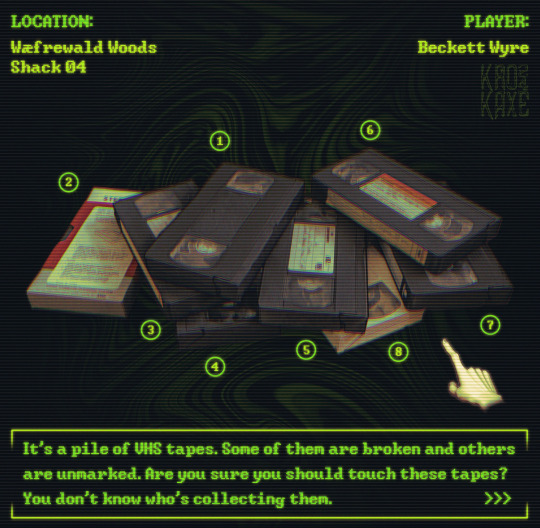
It's a pile of VHS tapes. Some of them are broken and others are unmarked. Are you sure you should touch these tapes? You don't know who's collecting them
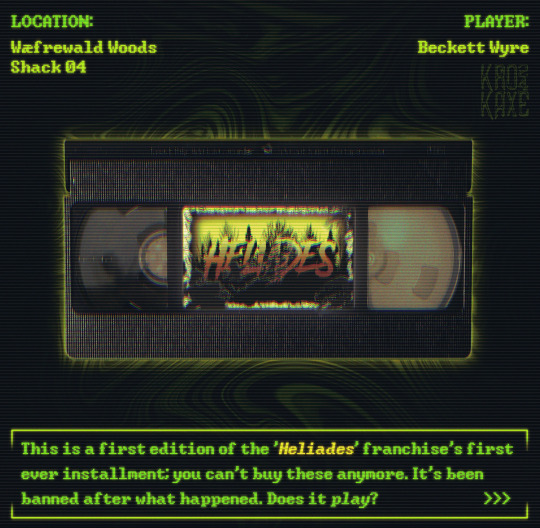
This is a first edition of the Heliades franchise's first ever installment; you can't buy these anymore. It's been banned after what happened. Does it play?
#krok.png#Horror#Concept Art#Fake Screenshot#Game Concept Art#Point and Click#Horror Games#OC: Beckett#VHS tapes live in a very special part of my heart#Aged media formats I love you#Digital behated (irony)#I remember when the move from shooting on film transitioned into digital#give us BACK the film grain#Arcadia#Skeinridge#The Conduit Tapes
21 notes
·
View notes
Text
Justice Mukheli On Telling Authentic African Stories Through Art
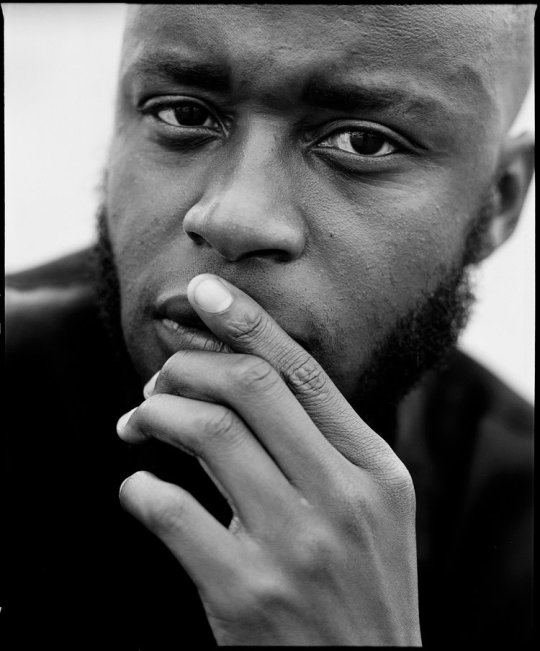
Justice Mukheli is a film director, photographer, and artist. Through his visual storytelling, he takes viewers through a journey of African stories that embody truth, power, and beauty. He documents everyday South African experiences through his lens which makes his art feel like home. It is evident that Justice Mukheli is rooted in his heritage as he draws inspiration from his upbringing in Soweto to enrich his work. Whether he is capturing on film or digital – his photography is full of soul, which can be seen through the eyes of his subjects. Art becomes a conduit for Mukheli to heal, breathing life into untold stories and contribute towards moving the African culture forward.
From working as an Art Director at Draft FCB to being a Commercial Director for Romance Films TV, how Justice Mukheli has constantly elevated himself through a plethora of creative mediums is truly inspiring. During our catchup in Rosebank over coffee, I learned more about his journey from advertising to art, how he achieved his tremendous success as well as his new path of being appointed the Commercial Director at one of the best production companies in the world, Romance Films TV.
1. How did growing up in Soweto inspire your vision of storytelling?
Growing up in Soweto inspired me in a lot of ways that are beyond the storyteller I thought I would become. The way we grew up and being a child at the time, Soweto was amazing. There was a freedom that kids don’t have – now that my life is this side of the world. Maybe on a weekend, I would just wake up and leave the house at 7 o’clock and go explore with my friends, come back before the sunsets. And it would be either from going to catch locust in the bush or creating our soccer field somewhere in the bush corner or playing under tunnels. We used to get under tunnels and walk. For example, we would get into a tunnel here, go through the tunnel, and get out in Bryanston. They were like a maze. There were so many activities as a kid. My childhood was amazing with memories and my parents were amazing. I was very close to my dad for the time he spent with us, close to my mum. She used to bake, we used to help her bake and knit. There was so much available to entertain me as a kid growing up in Soweto. There were these older gentlemen, friends of my uncles who dressed up incredibly beautiful and you grow up seeing that and aspiring to that. The car culture, sneaker culture, fashion culture – there was just so much.
2. What are some of the unforgettable childhood experiences you believe shaped who you are today?
When I get work or need to do or tell a story, I have a huge bank of resources and stories to borrow from, to look back into. I become excited about how I can bring those lived experiences into life, into the story I was trying to get. As a commercials director, when I get a brief most of the time, I look back there in my bank of memories. Have I experienced something like this? My latest commercial is about a funeral plan – this old man leaving his last message to his wife. So when I got briefed, it became immediately clear to me that I have experienced this. The point of view might have been different because I was a child but I can remember all those moments when my grandmother lost my grandfather and what happened and the nuance in how she was and how she dealt with the nuance of my culture and how we deal with loss. That was a huge and most incredible resource to go look into as a source of inspiration and borrow from. To breathe that experience into that piece so that it feels authentic. As a filmmaker and artist, we recreate moments and it’s in how close to reality we get. That’s my tool. It’s what I use all the time.

3. You recently joined Romance Films TV as a commercials director. How do you feel about this new path?
I am beyond excited about it. I wrote on my Instagram post that I have been inspired by Romance Films TV before I even thought that I would be a filmmaker. From 2009, when I got into advertising, I remember they would say to us when you write your advert you must write it for Grey Gray to take your script, to even consider shooting your ads for you. Grey Gray is a founding partner for Romance Films TV. He is incredible. He is an incredible storyteller. We used to write these ads and send them to their company. We would cross fingers that he considers our script. Unfortunately, when I was still in advertising I never got to work with him. Maybe our scripts were not good enough. It is exciting that the loop closed. I am excited to learn from them. There is Terence Neale who is incredible, he works mostly internationally. His ads are breathtaking, such as the ad he did for Beats by Dre. I have known them and had a friendship with them for a long time. It feels right to have joined them now because I have gained my own experience. I have scrabbled, built myself and built my confidence. I have proved that I can be a filmmaker. Now it’s amazing that I am part of a team that I have reached to be a part of for the longest time.
4. From working as an Art Director to being a Commercial Director, how did you navigate the transition from advertising to art and how did you own that space?
The transition was relatively easy. And I say this because advertising is an incredible teacher. Marketing teaches you how business works, positioning, and what you need to do to get a product to a certain target audience. I saw myself as a product when I started my journey as a photographer. Like okay cool, I’m a photographer. How do I get myself seen by those I want to book me? I had to build a portfolio using knowledge from advertising. I was in advertising for 7 years before I transitioned. My understanding of the industry helped my transition work seamlessly because I knew what to do. I knew the power of a portfolio, I knew how to get myself in front of the target audience that I need to book me. Owning the space was putting in the work and understanding what is needed to get myself to a position where I am considered or seen as someone interesting in my field or someone who has a different point of view or a different way of doing things. That is part of owning the space and creating work that is unapologetically my voice. And in the same vain, answering the client’s brief and aligning the brand with its target audience. And aligning the brand where marketers intend to get to. I make sure that my work is an extension of what my clients need. As a film director, I am a part of the chain.
Your voice is your own lived experience. For example, when I got briefed on Hollard, there were 2 other directors. There were 3 of us. It’s always important that I borrow from my lived experiences because it will be a unique point of view, a unique point of departure. After all, all the other directors will also come from their point of view, understanding, or lived experiences. That’s how they work and when I present my treatment it will unapologetically be me. It will have my voice, tone, and feels. With Hollard, the way I saw and experienced my grandmother grieve for my grandfather is unique to me. So I reconstructed and rebuilt that world from how I saw it.
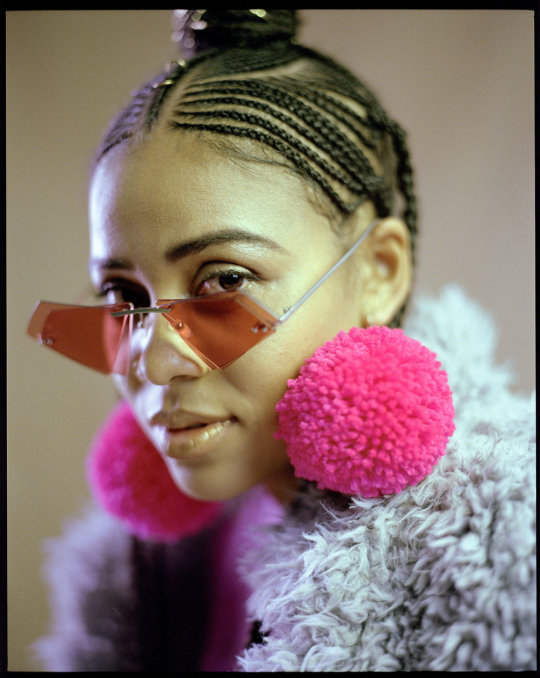
5. In terms of your photography, what qualities must a subject have for it to be captivating enough for you to capture it?
For me, it’s not about aesthetic qualities, it’s about the feeling I get from the eyes. It’s not an aesthetic thing. It’s mostly eyes and the feeling that I am trying to capture. My creative process is led by feeling rather than an idea. The idea is secondary to me. For me, the important thing is how does it make me feel. I have always felt that advertising teaches us that “idea is king” and I agree. But for me, the feeling is more important than an idea because you can get an idea but it doesn’t move you. The feeling is more important to me. Sometimes I use to gravitate towards kids a lot because it was a process for me to unpack my other lived experiences - emotions I never got to deal with acknowledge or immerse myself in. Sometimes when we go through what we go through, we are not present enough to go through the emotions of it and deal with it. Photography and film have become a tool I use as therapy for myself. I can tap back into a moment that is important to me and I deal with it, and I can capture that feeling.

6. In your tremendous career, which would you say are your favorite works that you have produced and why?
I love the Ingrams advert and the Hollard advert. There is an advert I have created for South African Tourism, it has a slightly different tone than the ads I am creating now. It was about portraying black people experiencing their land on these spaces that are mostly enjoyed by white people but enjoying them their way. I quite like the advert.
7. The advertising industry in South Africa has transformed in terms of how black culture is represented, however so much work still needs to be done to move the culture forward. What do you think agencies can do better in this space?
Agencies still fall into the mistake of not being mindful of black stories by black people, or at least having black collaborators in the chain of those stories being told. I think the industry very quickly falls into thinking that “ALL LIVES MATTER” type of mentality, that creative is creative. “What makes you think that just because I am a white person I won’t be able to tell a story in a sensitive way?”. I don’t think that’s the conversation. I think the conversation is telling the story most authentically and mindfully. I think advertising needs to create space for black narratives to be inclusive of black people from the process of creating it.
8. If you ever feel a creative block during a project, how do you reconnect and channel your energy?
I have a lot of creative resources and creative outlets. If my photography is struggling, I am going to paint. Now, I have decided that I want to paint again because I am not so inspired photographically. I am going to start to paint more. If directing or my other outlets are struggling, I can make music or I can sculpt, or I can write. I have a lot of outlets.
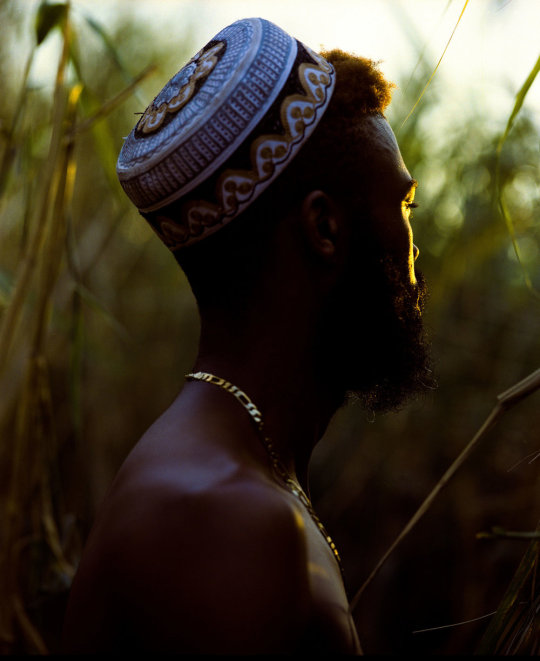
9. Which creative materials inspired you on your overall journey? It could be a film, book, exhibition, documentary, or anything?
It was a book by Malcolm Gladwell called Outliers. It speaks of the 10 000 hours rule and it touches on the people who are amazing that we love and follow. The people who inspire us decided to put in the work, it didn’t happen by chance. That book taught me that whatever I want to be, I can be. I can make that happen, no one else. And it can never happen by mistake.
10. Which brands and artists would you like to collaborate with in the future?
I would love to work with Netflix. And in terms of artists, there is an artist I like called Sibusile Xaba. He’s really amazing. That’s who I would love to collaborate with.
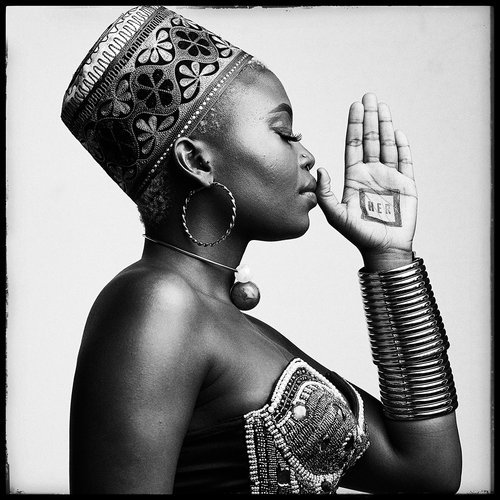
11. And lastly, which words of advice would you give to young artists who aspire to manifest their dreams in this multifaceted creative industry?
My last words would be what I just said about what I got from the book, Outliers – what you want to be, only you can make happen. Great people are not just great by mistake. It just doesn’t happen to them. It was a choice. If you want to be amazing at something, you need to decide to be. It’s a process, it won’t happen overnight.
Image sources: https://www.justicemukheli.com/work Justice Mukheli Films: https://www.romancefilms.tv/directors/justice-mukheli
#SOUTHAFRICANART#thelifedocumentor#Zesintu Mgobhozi#lifestylebloger#African photographers#african art#justice mukheli
2 notes
·
View notes
Photo
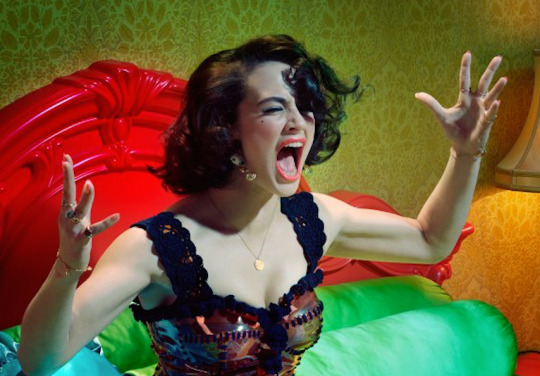
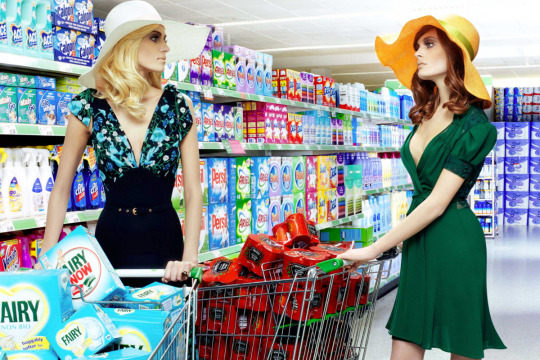
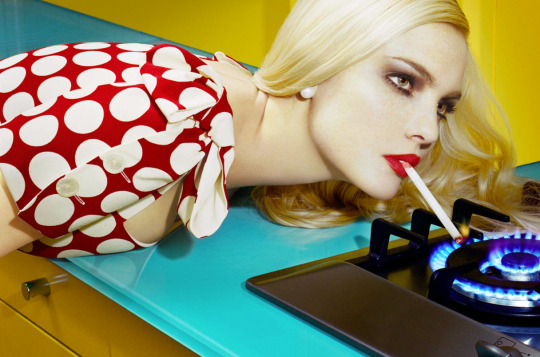
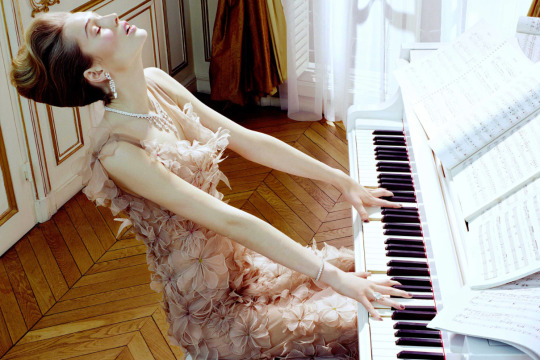
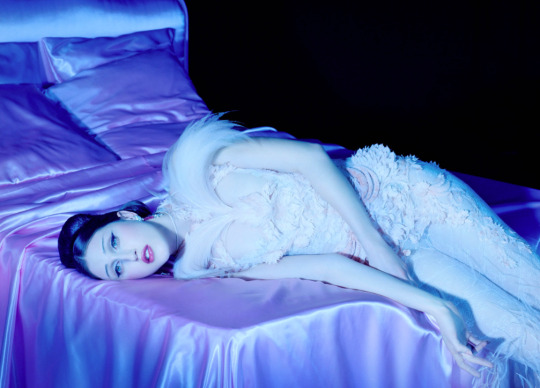
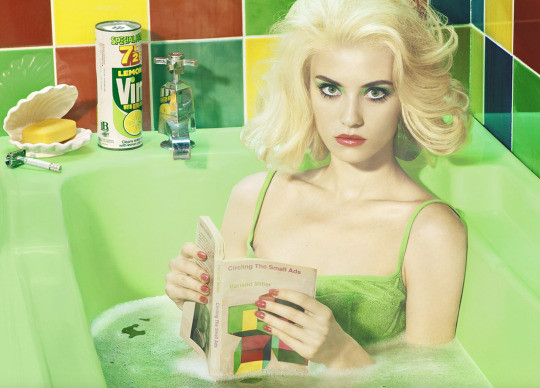
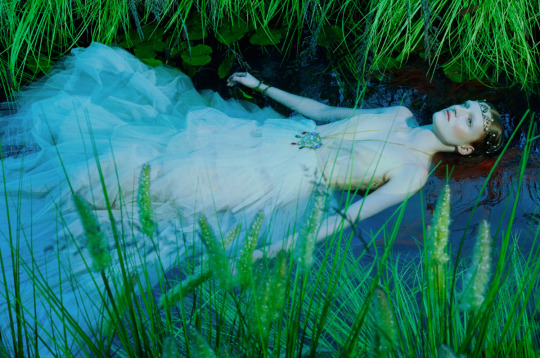
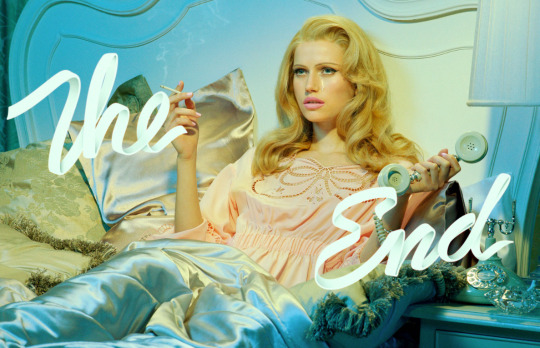
The second of a two part Miles Aldridge interview I did for the Image Source Picture Agency. Here, the avant-garde fashion photographer talks about the transition to a different creative vision, and the contrasting influences of Richard Avedon and Helmut Newton.
Ashley Jouhar: The transition you made to the kind of work that we associate with you as a photographer now… how did you go about creating that imagery?
Miles Aldridge: Well as an example, I had this idea for a photograph that took place in a car, with the exhaust coming through a window. That could still work as a photo. I wanted to do a series like that but what other ideas could I come up with? I went through the other ideas and they were all to do with suicide! That’s how it started to happen.
The people I worked with were very accommodating, especially Italian Vogue. I’d done white background shoots for them for quite a while. So when I proposed to do something with a bit of narrative to it, as along as I shot their clothes they were fine with it. Actually, those pictures turned out quite well – they emboldened me to do another one and another one.
Some of the early stories aren’t much of a story but there is still a story there because something is happening. I remember one where I just wanted to have a white kitten in every picture. Following this girl around the street loosely inspired by this girl from La Dolce Vita. That was a case of making sure there was a white kitten on set and just making sure it was in every picture.
Ashley Jouhar: How long does it take now to make an individual image and what’s the size of the team involved?
Miles Aldridge: The team is the same now, it’s a bit like a Rock ’n’ Roll band. Instead of the drummer, the bass player and guitarist, you have the stylist, hair-dresser and make-up artist, the set designer and the prop stylist. It is like a small art movie team – it’s not Hollywood. It’s a group rather than a massive bunch of people. I try to keep control of it, keep costs down. So it doesn’t becoming exorbitantly expensive. As long as my drawings are quite accurate from the beginning, I don’t have to make huge sets, I just make the bit I really need.
Typically I’ll have an idea and I’ll sell the idea to the magazine. Within that six months we’ll shoot it as an idea, over two days mostly – sometimes over one day. Now half the shoots are one day shoots.
Ashley Jouhar: Is it mostly sets you shoot in rather than locations?
Miles Aldridge: It goes up and down, I go through different phases, sometimes I like shooting in locations as I find locations give you a lot more options once you are there. They exist in architectural space. If the idea you had thought of doesn’t work, you can probably move the camera and find something else that does work. Whereas a set has no Plan B. You are pretty much figuring out your shot when you are doing a drawing and have the set constructed accordingly. It’s quite nice going into a location like a hotel room and taking it over changing it and putting lights up and really doing a number on it. Changing it through the camera, though the lighting, and propping. I’m quite happy in a studio as a set as well.
When you have a free rein, and it sounds like a lot of the time you have, it can be more difficult to create, as the world’s your oyster. How do you impose your own parameters to get to be where you want to be?
Because I work for Italian Vogue the parameters are not defined but are well understood. You can do a picture of a crazy woman but it does have to be tasteful, it can be contemporary so it can include knowledge of contemporary art but I think it can’t be shocking for its own sake and it can’t trample over certain taboos.
There’s a restriction there and of course you have to show the clothes. And I’m also obliged to make sure that the woman looks really beautiful even if she is weird. There are enough parameters there to make it interesting. I agree though, when artists are given free rein, they often produce rubbish. I like to consider myself working in a similar way to the Hollywood writers and directors in the 1940s and 50s… Celebrating that and everything in between.
Ashley Jouhar: When we were talking at your show Short Breaths, about film versus digital, you were saying you do some commercial jobs on digital but mostly you are shooting on film to get the qualities it provides. For shoots for Italian Vogue for instance, would that be film?
Miles Aldridge: Absolutely. All the work in Short Breaths and all the work in Somerset House was previously published in magazines and ninety percent of that was Italian Vogue. For me, the personal work is the magazine work – I consider that my art, in the same that Richard Avedon and Helmut Newton did too. I don’t consider that commercial work even though it’s for a magazine. What I consider commercial work is pure advertising, where it’s a product for a company who want me to show their things. You have to work with someone else’s brief in advertising. Historically, editorial photographers are reporting on the world. They are aware of fashions and the world they live in so the ideas they have and the images they come up with are not just to show the clothes – that would be deadly. The job of the fashion photographer is to subtly make comment on the world he lives in.
Ashley Jouhar: Which fashion photographers have influenced you? Whose work do you like the most?
Miles Aldridge: I think as far as being incredibly serious about what he did – and he straddled such a huge period of human culture and commented on it, it would be Richard Avedon. Helmut Newton is also a very interesting and prolific artist who did the same for a more concentrated period in the 70s and 80s. He did in the 60s too but came into his own in the 70s. He was such a pervy, dark guy but I think that vision suited that world of the 70s. Both of these artists are true to their own nature. There is something about Avedon and his obsession with grace and glamour but he was massively aware of the world he was in, the Berlin Wall coming down, the rights of Black people, or the American West project being a shocking report on one of the world’s richest countries.
Ashley Jouhar: He was heavily criticised at the time for some of these images. But look how influential they’ve been.
Miles Aldridge: Irving Penn is another one. He is less a fashion photographer than a still life one. In his way, he has an incredible breadth to his work, a huge span of human existence that’s fantastic.
Ashley Jouhar: I saw the Platinum Cigarette Butts show at Hamilton’s last year – phenomenal to see them all together…
Miles Aldridge: Wonderful…
Ashley Jouhar: And again very influential…
Miles Aldridge: Like a lot of great work, if the idea is great you can get the cigarette butt out of the gutter and put it under a camera. He followed it through technically and did it brilliantly, but for me the brilliant bit of that is the idea. He said, walking home from the studio, he would pick up these little bits of detritus and bring them back to the studio the next day to photograph. It’s the idea to do that that’s the amazing thing.
Ashley Jouhar: It’s easy to look back at stuff like that and say, well… that’s an old idea but of course, at the time it was breaking new boundaries…
Miles Aldridge: And in its own way it was talking about consumerism.
Ashley Jouhar: One more question. Your current body of work has an ‘energy’ and a ‘Miles Aldridge’ look and feel. Is anything hatching in your mind as to how you are going to move it on? Where are you going to go next with your style or approach to image-making?
Miles Aldridge: The exhibition and the book are both incredible full-stops for me – a double full-stop. I feel the new work after this, starting in September, will be different. What I am doing right now is really considering that. I feel the body of work at Somerset House is a really complete representation of how I felt about the world up until now. Now that’s off my chest it leaves room for me to think again and see things in a different way.
Ashley Jouhar: Thank you very much Miles.
#fashion photography#fashion#art photography#pop art#ashleyjouhar#miles aldridge#british vogue#vogue italia
2 notes
·
View notes
Text
GRETA GERWIG TALKS TO FRANCIS FORD COPPOLA
Excerpts from Interview Magazine November 2, 2017.
COPPOLA: Let’s start at the beginning: When did you stop believing in Santa Claus?
GERWIG: I got an easel for Christmas—I think I was 7 or 8—and the easel had “Merry Christmas” written on it in all these different colors, and I recognized my mother’s handwriting. I said, “That’s not from Santa Claus. I know that’s your handwriting.” And then I proceeded to do a dance around the living room saying, “I figured it out, I figured it out.” And while I was doing that, I started weeping because I thought that meant there was no more magic in the world. That story actually says a lot about who I am now. I get this pleasure in figuring things out, and then it turns into complete despair.
COPPOLA: Did they own up to it when you discovered the truth?
GERWIG: They did, because they thought I enjoyed it and didn’t realize I was going to turn so quickly. I had a similar thing with movies. I thought movies were handed down by God. I knew that theater was made by people because I saw the people in front of me, but movies seemed like they were delivered, wholly made, from Zeus’s head or something.
COPPOLA: As a kid, were you a big reader?
GERWIG: Yes. Books and theater were the way I understood the world, and also the way I organized my sense of morality, of how to live a good life. I would read all night. My mom would come into my room and tell me I had to go to sleep, so I would hide books under my bed. At first I had a tough time getting through novels, so I read plays, because a play is generally shorter and has all those tools for getting people hooked early on.
COPPOLA: What was the first play you can remember reading?
GERWIG: I remember reading a lot of Eugene O’Neill and Arthur Miller, and being so impressed by Miller’s stage directions. He included very detailed descriptions of how the set is supposed to look, and that allowed me to be inside the plays even if there wasn’t a production going on. In terms of sheer pleasure, Tom Stoppard was very big for me because he is so funny and so smart, and it felt delicious reading him. I got it in my head that there was no way I could ever make plays because you would have to be so incredibly smart, and I was not going to be as smart as those people.
COPPOLA: What was it like making the transition from your early films—when you were practically in college—to these more established ones?
GERWIG: I wanted to be a playwright in college. That’s what I was interested in and that’s what I was moving toward, and then I had the very lucky accident of falling in love with film. Like we were saying, it wasn’t until I was 19 or 20 that I realized films are made by people, and I had the good luck of suddenly meeting them. Shooting digitally became cheaper and better. Editing became something you could do at home. You couldn’t make something that looked like a Hollywood film, but you could make something through which you could work out ideas. I was acting, but I was also conceiving the plots and operating the camera when I wasn’t onscreen or holding the boom and sitting there at night looking at how it would be edited together. In a way, I got very unvain about film acting, and it became a sort of graduate school for me. At the same time, I was busy getting rejected from every real graduate school I wanted to go to for playwriting. [laughs]
COPPOLA: ...when I lived on Long Island I wanted so badly to live in New Orleans. And then years later I did go to the French Quarter—it’s a wonderful place to visit—and I thought that I was going to write plays and have a girlfriend and all of the things that I wasn’t having, but I didn’t.
GERWIG: I once went through a major Sam Shepard phase, and I thought, “I’m completely in the wrong place, and I’m the wrong gender! And I’m also not a heavy drinker! And I need to somehow become a wild man and go out to the West and learn how to rope cattle!”
COPPOLA: I don’t think Sam Shepard knew how to rope cattle.
GERWIG: Well, he seemed like he did! I think the problem with growing up and idealizing self-destructive artists is that you only see the beauty they created rather than all the pain that went along with it. But then I read Joan Didion, and it was the first time I’d read something by an artist—a great artist—who was working in the same place I was from and writing about it, and it was the first inkling I had that maybe I didn’t need to be a different person in order to make something that was worth anything.
COPPOLA: That’s what your film is about, isn’t it?
GERWIG: I guess it’s a revelation I’m still dealing with.
4 notes
·
View notes
Photo

Life in Film: Michael Tyburski.
The Sound of Silence director Michael Tyburski shares some insights into the making of his debut feature, and answers our new “life in film” questionnaire.
In The Sound of Silence, Peter Sarsgaard is Peter Lucian, a house tuner in New York City who believes that the notes emitted from a household’s appliances must harmonize in order to bring peace to its residents. However, his state of mind collapses when he struggles to apply his methods for a new client, Ellen (Rashida Jones).
Directed by Michael Tyburski and based on a short film he made with co-writer Ben Nabors in 2013, The Sound of Silence debuted at the Sundance Film Festival and stood out for its “remarkably silly” unique premise and strong performance from Sarsgaard. Fans of ASMR, get your headphones out; the film’s sound design will trigger those sensations.
The Sound of Silence started life as your short film Palimpsest. Is the ‘house tuner’ occupation at all based in reality? Michael Tyburski: The short answer is no, it’s a fictional profession. The character idea is something that my co-writer Ben Nabors brought to me. Right away, I loved the idea of a practise where someone shows up at your door and offers you a solution to the emotional problems that you’re having.
A lot of alternative therapies exist in New York City so it didn’t seem so far from reality that people would take someone intellectual, dressed well in a tweed blazer, with professional-looking tools, seriously. I really liked that as a conceit. We tried to base it in real science and looked at sound engineers and acousticians for what tools they would use. We tried to make it exist in a very real New York City; that’s why we have touchstones like the character being profiled in The New Yorker.
How has your research into music theory affected your own domestic space? Actually, I moved, for the first time in ten years—after living on a pretty noisy commercial street—during the course of developing and making this movie. Somehow, during the edit, I made my first apartment move within New York City, to a much quieter street. I also took a cue from the main character, Peter Lucian, because I moved my office below my apartment, in a subterranean space. At least I can control the sound a little bit more now that I’m cut off from the surface level, similar to the way Peter does it in his “fallout shelter”.
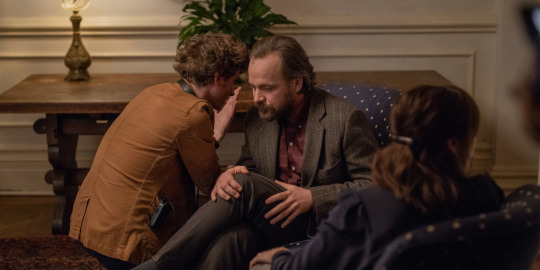
Michael Tyburski and Peter Sarsgaard on the set of The Sound of Silence. / Photo: James Chororos
The character Peter Lucian feels like a perfect fit for Peter Sarsgaard. When did you have him in mind? He was my first pick. I knew I wanted him from the beginning when I first started thinking about who would be the perfect house tuner. I feel so lucky to have him and fortunately the script resonated with him right away. He’s someone who’s very musically inclined and he plays a number of musical instruments. I was so gratified that he connected to the part so closely.
He’s such a chameleon of an actor. He can play a lot of dark roles, but also he has a very scientist-like intellect. I also think he has one of the best voices, it’s very unique and I enjoy hearing him. So for a movie about sound, it kind of seemed fitting that someone with those types of qualities would work for the role.
What was important to you about keeping Peter’s house-tuning technology analog instead of digital? I think he’s just someone who has the philosophy of “if it’s not broke, don’t fix it”. Even though his tools are a little more dated, they’re still as effective. They might not be as efficient as digital technology so he’s a little slower, but they still work. There is at least one sound engineer in New York City who we found in our research who measures the sound in rooms, and there’s one thing called a spectrum analyzer that we use in the film that we completely got from this guy’s tool bag.

Director Michael Tyburski.
The film is carefully crafted and you have Peter obsessing over every inch of New York City. What degree of obsession did you have in the making of the film? I’m pretty obsessive as an individual in general. I like to be very organized and have everything mapped out. We had been developing the screenplay for so many years that I got tired of reading it, so before we made the movie, the first thing I did after Peter came on board was sit down and record the entire script in audio format. I kind of had this radio edit of the movie. That transitioned into a rough animatic of the film that I put into the timeline and I was able to add in location references, tonal reference photos, dialogue in different room tones, and then music.
Logistics-wise, we only had 21 days to shoot the movie which is very conservative especially because we had a lot of ground to cover, but I just needed to be as efficient as possible, so it was helpful to have that thorough, animatic tool.
With all the technical departments it was a very close collaboration and I like to be very involved in all details. For the sound design, I wanted to re-record all of the tuning forks, which were kind of an aural motif through the film. When you’re shooting in the elements, you don’t always have the control over the environment, so I hand-recorded each one of the tuning forks myself. We were aiming for that level of precision.
We’d like to ask a few questions about your life in film. What was the film that made you want to become a filmmaker? My choice is probably not that unique but when I was 13, maybe a little too young, I got a VHS copy of Pulp Fiction. That stunned me and took me from A to B. It shook up how I thought contemporary American stories could be told.
Which film do you think is the best love letter to New York? Annie Hall, closely tied with Midnight Cowboy. I suppose I love that era of New York.
Which film has the greatest sound design work of all time? There’s a lot, but one of my favorites is Play Time.
Nice choice. Greatest production design of all-time too. Yeah, not bad. I used a few frames for my look book.

Jacques Tati’s ‘PlayTime’ (1967).
Which is the most overlooked performance from Peter Sarsgaard? I loved him in Experimenter, which I think is an underrated film. More recently too, Errol Morris’s Wormwood. I don’t know how many people went down that rabbit hole because it was long, but I think he was so good in it.
What films did you watch to prepare you for The Sound of Silence? There were three that we were looking at, for a lot of different reasons. We watched Jonathan Glazer’s Birth for the mood and that fairytale vibe it has in a mysterious, alternate New York City.
Being John Malkovich for its bizarro version of science, and I love the naturalistic quality to that film. And obviously The Conversation for its production design and how it follows a man obsessed with sound.
This is a nicely-timed, autumnal, gentle film. What films give you those peaceful autumn vibes? My favorite is Hannah and Her Sisters.
What mindfuck movie changed you for life? I’ll have a couple Kubrick on this list, but for this probably A Clockwork Orange.
It’s Halloween next month. What movie do you watch every Halloween? The Shining! There’s my next Kubrick.
As a teenager, what film character felt like a total mirror to what you were feeling at the time? One of my favorite coming-of-age films is Harold and Maude. I definitely identified with Harold.
What’s your go-to comfort movie? And how many times do you think you’ve seen it? My favorite film of all time, which I promise will be my last Kubrick, is Barry Lyndon. I think it’s just a perfect movie and I’ve certainly seen it dozens of times. I think it does everything I want in a movie. I don’t even know what genre to call it because it’s funny, it’s dramatic, it’s an epic. I love the idea of doing a perfect epic movie that covers a lot of ground.
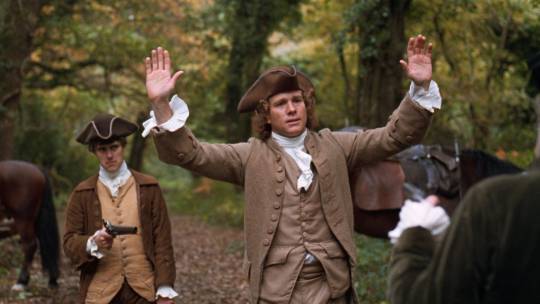
Stanley Kubrick’s ‘Barry Lyndon’ (1975).
What film do you have fond memories of watching with your parents? We were a big Chevy Chase household and National Lampoon’s Vacation holds up as a fine movie.
What’s a classic you could just not get into? Maybe Brazil. Admittedly I think I need to rewatch it because I first saw it when I was 14 or 15 and I just didn’t quite get it at the time.
What classic are you embarrassed to say you haven’t seen? Two Kurosawa films; Rashomon and Seven Samurai. They’re always on my list to brush up and they seem to come up in conversation more and more.
Which movie scene makes you cry the most? Definitely the holiday classic It’s A Wonderful Life.
What film was your entry point into non-English language cinema? That was a good one, I like that question. I remember when I was in my freshman year of high school I was given two VHS copies from someone who knew I was getting into film. One of those films was Persona, but then the other one, which I knew I watched first, was a film called Woman in the Dunes.
What filmmaker—living or dead—do you envy the most? If Kubrick, go for living… If it’s Kubrick go for living? Oh my gosh.
I feel like you’re going to say Kubrick. Yeah. Envy is a funny word. Kubrick has an admirable career for the depth of his filmography. You know, like a lot of film nerds I’m a huge Paul Thomas Anderson fan.
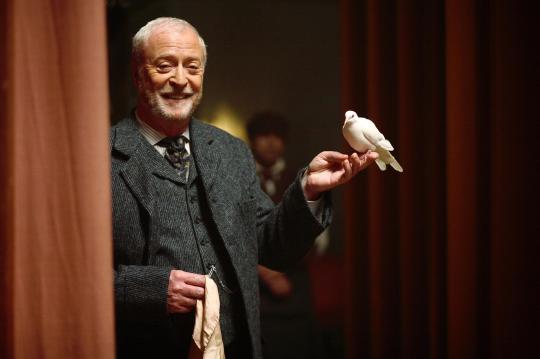
Christopher Nolan’s ‘The Prestige’ (2006).
What’s a film that you wish you made? I would love to make a movie about magic but ever since I saw The Prestige I think it would be hard to compete with that. That period, that Victorian era of illusion, I don’t know if you can top that.
It’s time for best-of-decade lists. What’s the greatest film of the 2010s? If we went back even further it would be easier. For the last 10 years, I think Phantom Thread is pretty great.
‘The Sound of Silence’ was released on September 13 by IFC Films and is in select cinemas now.
#the sound of silence#michael tyburski#peter sarsgaard#new york#kubrick#filmmaker#director#best of#letterboxd
3 notes
·
View notes
Text
Get to know me tag

I got tagged by @havokhayley so go blame her for me shit posting 😘
Rules: Tag 10 followers you’d like to get to know better!
Name: Edie
Birth Year: 83
Sign: I’m a (third generation) cuspian, so I’m Cancer/Leo. Does that explain everything about me? Kind of.
Height: 160 cms, so 5ft 2.
Put your playlist on shuffle and name the first 4 songs:
Playdate - CBX We Go Up - NCT Dream Sunshine - Hoody One and Only - EXO This is terrible representation. I usually skip 1&Only. I’m so not a ballarder. I have one Nct Dream song in a giant kpop playlist and it comes up?! Honestly. Also, I have multiple kpop/sweet teeth related playlists which some of the anons have access to so hit me up if you want a link (only to known anons/mutals soz)
Grab the nearest book, turn to page 23. What’s the 17th line?
“But the most immediate predecessors of digital games were carnival games... (throwing a ball at a stack of bottles from a set distance), mechanical games (a shooting gallery with moving targets), and pinball machines.” -Chapter 2: The History of Magic from Rise of the Videogame Zinesters: How Freaks, Normals, Amateurs, Artists, Dreamers, Dropouts, Queers, Housewives, and People Like You Are Taking Back an Art Form” by Anna Anthrophy (2012).
Ever had a song or poem written about you?
Not that I know of. Perhaps my mother wrote a poem once or twice. She writes lovely poetry.
When was the last time you played air guitar?
A long time, I honestly can’t remember. I play air drums a lot though, and lip sync almost constantly whilst listening to music in transit.
Celebrity crush(es)?
Perhaps you’ve heard of them?
What’s a sound you hate/love?
Hate: Breaking bones. Love: I’ve said it before but female orgasms. God damn.
Do you believe in Ghosts?
Yeah, why not?
Do you believe in Aliens?
Yeah, why not?
Do you drive? If so, have you ever crashed?
Can drive, don’t drive, have crashed.
Being an Australian means you have a very specific relationship with driving and cars, but I was raised by two people who love cars so I was driving at an early age. The first car I ever knew was my parent’s pride and joy - a silver Porsche 911. My first car was a Datsun, and I have incredibly sentimental memories of the cars of my youth - especially one of my boyfriend’s - a red 1970s-80′s GT Celica... you can guarantee that if I write a fic with a car in it (like Sehun’s), I’m probably imagining the bonnet of that GT in my head.
Last book you read?
In total? - probably when I read Michel Foucault’s History of Sexuality Pt. 1. However I read a lot of bits of books at the same time, so I read Lord of the Rings for example, when I can’t sleep, and I have an audiobook of The Stand by Stephen King that I occasionally dip into when I feel like it.
Do you like the smell of gasoline?
I mean, see my answer on Australians and cars, but goddamn yes I’m one of those gas huffing bitches who rolls down the window at service stations.
The last movie you saw?
For someone who studies film I’m currently not able to consume a lot of it - (when you’re studying something as closely as I am it’s sometimes hard to look at similar stuff without feeling overloaded?) so the most recent thing I watched was Mission Impossible Fallout. We bought the dvd around Christmas, thinking it would be a bankable ‘good shit film’, as I was a huge fan of the last 2-3 of the MI films, and oh my GOD WAS I DISAPPOINTED. The sexism! The shitty script! Oh god it was BAD. I wanted to break the dvd.
Do you have any obsessions right now?
Um.... perhaps you’ve heard of him.
Do you tend to hold grudges?
Oh boy and how. I’m the kind to remember exactly what someone said to me one time and hold it against their character forever. It’s a horrible trait but I secretly love it. I spot assholes at a thousand paces, that’s what 10 years spent working in bars/restaurants/cinemas/ record shops/cafes/anything public facing will give you. I can meet someone and instantly dislike them, so when that’s paired with them actually being a jerk to me, it’s like they’re on permanent ‘shit list’ in my mind. Terrible.
Are you in a relationship right now?
The ring on my finger says as much.
Tag:
I don’t usually tag followers because I know a lot of you like your privacy (totally understood) so instead of tagging them Imma tag @feedmeramyun @thotantics and @rosyyeols ❤️
7 notes
·
View notes
Text
Avenue south residence price list
For over three decades I had been in the advertising and commercial film industry working with the talented, rich and famous. At the end of this, I thought I could disappear into quiet. I began my Madison Avenue advertising career in the heyday of advertising in the mid-60's, last century, at the top of the ad game, Young & Rubicam. Y&R had the top accounts, creativity and billing. It was a great place to work; if your family could initially afford to send you there (their starting salaries reflected their entry value). After a few restless years of changing departments four times we both (Y&R and I) finally realized corporate America was not the right fit for me and I went back to NYU film school and jumped to the other side: commercial film production. I was destined to keep working with the talented, rich and famous. Fate continued to linked me with some of the most talented commercial and feature film directors in the world; the likes of Ridley and Tony Scott and George Lucas. The Scott brothers and I, along with many multi-talented people, founded Fairbanks Films and that company took over the commercial film production advertising world in short order producing such famous TV commercials as the "1984 Apple Computer" spot that launched cyber technology into the world. Then the Lucas films people decided they wanted to get into the advertising game. And why not? After the motion film industry, the advertising business was making as much money as anybody. So over to Lucas I went with all the inventive, digital technology at hand. It's fair to say, we taught the Avenue south residence price list advertising world digital wizardry, even though others jumped on quickly. It was great fun being the director of marketing of the commercial division teaching the ad world how they could bring any image to the screen, if only they had enough money and time. We changed the look and abilities of commercial film forever producing thousands of spots worldwide. Many of these spots became household icons. During my three decades, I got to know the planet up close and personal and it was more than anyone could ask out of career! So I thought when it came time to retire I surely would be ready for peace and quiet. Wrong...
If you are in the film business, you get to know California really well. Or at least I thought I did. The weather, locations, studios and crews made California an almost MUST on any production schedule. Only strikes and cheap clients would prevent you from shooting in California. Fairbanks Films was my finishing school in southern California and the Lucas organization completed northern California. George Lucas preferred the north over the south (for reasons we won't get into).
While commuting to northern California from New York City my entire time with Industrial Light & Magic Commercials/Lucasfilms, I often took advantage of the natural wonders this part of the world has to offer. One of my most memorable trips was driving to the top of Mount Shasta, just south of the Oregon border. Mount Shasta is part of a dramatic volcano mountain range that snakes its way north. The size and grandeur of this mother of mountains was amazing; you could see it from 100 miles away. We had nothing like it on the East coast. And I thought enjoying its wondrous size and beauty was enough at the time. I would later learn otherwise... Ten years later I would return 'retired' for another purpose entirely...
Some say as we grow older and get closer to leaving, some become more spiritual, women become more masculine and men more feminine, or something like that. Well, anyway after some medical mishaps and 'enough is enough' syndrome, I did leave film and advertising. I mean what else was I going to do, produce another commercial? The last spot we did was the biggest commercial ever created for Ford motor company (90 days of shooting all over the world, the largest budget ever, aired all over the world; this was the perfect swan song. Did I need another cue? No! And there was this curious notion that something inside of me was awakening... Something else was next...
My mother was American Indian descended and my father Irish. My father's Celtic grandmother, my great grandmother, was a back woods Alabama healer. I call it my "I" and "I" links (Irish & Indian, both known for native healing). I remember sitting by great grandmother's bedside as a young child listening to her stories of her healing potions and how people would walk for days to get to her for "a healing."
She knew how to pick herbs from the forest floor and turn pine tree sap into a soothing medicine. So I imagined this ability was also in my DNA. And it was.
Filmmakers are often multi-faceted people and while I was working with one of my film directors on a project I developed a cold and shared my family's healing background. My director-friend immediately suggested that I see his alternative medical doctor named Dr. Herbert Fill. This filmmaker knew I was at the end of my film career and there was more to cure than a cold. Dr. Fill was a rare mix of psychiatry, acupuncture and homeopathic remedies, and commissioner of mental health in the city administration; all this in a Park Avenue office. It was not long before the patient became the student of alternative medicine under Dr. Fill. This was my transition from advertising into the "healing arts."
Once my transition, or should I say, my transformation began it went fairly quickly. After a couple of years of studying under Dr. Fill, I easily moved into energy therapy training called Reiki and Light Ascension; and became certified in these. These new alternative medical worlds introduced me to an entirely new community of people not associated with advertising or film. I began to know this was not going to be the beginning of a quiet retirement but a reinvention of self.
0 notes
Text
Henry’s

.bmc18-nav, .bmc18-nav--row, .bmc18-nav--item { display: block; font-family: sans-serif; line-height: 1em; } .bmc18-nav { margin-bottom: 1em; } .bmc18-banner--main { display: block; width: 100%; border-bottom: solid 0.25em #fff; } .bmc18-nav--item { text-align: center; padding: 0.5em; font-weight: bold; text-decoration: none; background-color: #ec3b9a; color: #fff; border-bottom: solid 0.25em #fff; transition-property: background-color; transition-duration: 0.2s; } .bmc18-nav--item:hover { background-color: #39b54a; color: #fff; } @media screen and (min-width: 480px) { .bmc18-nav { display: table; width: 100%; table-layout: fixed; } .bmc18-banner--main { /*border-bottom: solid 0.5em #fff;*/ } .bmc18-nav--row { display: table-row; } .bmc18-nav--item { display: table-cell; vertical-align: middle; border: solid 0.5em #fff; } .bmc18-nav--row > .bmc18-nav--item:first-child { border-left: 0; } .bmc18-nav--row > .bmc18-nav--item:last-child { border-right: 0; } }
Complete Listings Overview Learn More

Henry’s stores offer free classes on topics like vlogging and freezing motion (Photograph by Christie Vuong)
Gillian Stein started her journey to becoming CEO of Henry’s, her family business, when she was just six years old.
“One of my earliest memories of working in the store was spending Saturdays on the fourth floor of our building,” she says. “It was just a giant warehouse. I remember one time there was a misprint in a flyer, and I spent all day with my sister pulling flyers from the papers. We were covered head to toe in ink. When you grow up in a family business, you’re in it from birth!”
Henry’s—which was started in Toronto in 1909 by Stein’s great-grandfather—now has 30 locations and 400 employees across the country, but its continued success in a crowded market is due, in no small part, to an almost religious commitment to maintaining that local-store feel. Its employees may not be wandering around covered in ink, but they’re all passionate about the products they sell. That’s because there’s no one on the floor at any Henry’s who isn’t also a content creator themselves.
“They’re photographers, cinematographers, vloggers, YouTubers, Instagrammers . . . they’re part of the community they serve,” says Jeff Tate, Henry’s vice-president of marketing and e-commerce. “When you come into a [Henry’s] store, you’re going to talk to someone who’s probably going out to do their own shoot that weekend. They don’t want to just sell you gear—they want to help solve your particular creative problem.” Fostering personal, long-term connections with shoppers who share common interests is a point of pride.
“The way Henry’s looks at their customers is very different,” says Ryan Courson, store manager at Henry’s in Kitchener, Ont., and an equine photographer. “It’s not an environment where customers are numbers—[we don’t] just sell them whatever we can and move on to the next customer. It’s more about building relationships. The staff are all fellow photography and videography enthusiasts. There isn’t a staff member in the store who doesn’t have people come in and ask for them by name.”
One name every employee knows is Gillian’s. Stein meets regularly with staff from coast to coast in a program called Coffee with Company. Henry’s isn’t a one-store operation anymore—the company started expanding beyond its Toronto location in 1992—but Stein still wants to learn from the front-line workers, as if it were.
“It’s important to have a close relationship with employees,” she says. “I’ll ask them questions and tell them about things we’re thinking about. We’re always trying to get a better sense of what they see.”
Those eyes and ears on the ground have played a large part in Henry’s recent innovations. For one thing, “Canada’s greatest camera store” doesn’t actually think of itself as just a camera store—it’s a place for creators, especially digital ones who are making content for online consumption on an ever-expanding list of platforms, all of which come with their own particular gear challenges.
“That entry-level of the market where everybody needed a camera to take pictures on their vacation is gone,” says Tate, “but because of the internet, there are more content creators than ever before. Some people like watching gamers play video games on Twitch . . . well, great! Those gamers need a camera pointed at their face, and audio and lighting. If you’re a vlogger, you need something portable that picks up audio. We adapt to what people are making—this is the growth part of this industry.”
Henry’s product offerings have expanded to feed this booming customer base. Need a drone so you can film yourself from above skipping through a vineyard for your travel website? Done. Want a pretty backdrop for the picture of that lipstick you’re featuring on your blog this week? No problem. The company has sponsored several indie and influencer events and festivals, and is even catering to podcasters with a healthy selection of microphones and other audio tools. In some stores the area that used to feature printers is soon going to be devoted to this kind of equipment. The company is also working on a digital platform (details are hush-hush) that will help connect content creators with all the various services and people they need to help grow those side-hustle hobbies into main-hustle brands.
With this in mind, of course Henry’s has its own official in-house content creator, Gajan Tharmabalan, who spins the plates on all of the brand’s social media platforms. He makes content, of course, including how-to and product-review videos, but he also uses the channels to engage with Henry’s growing network of fans, and to promote the work of other photographers, filmmakers, You-Tubers and Instagrammers. This added focus on serving influencers means that Henry’s is not only nurturing customers who are much younger than the middle-aged male who, historically, is the camera-store client, but it is also attracting more women than ever. After all, female You-Tubers, vloggers and podcasters need gear, too.
“These new customers really didn’t have a home in terms of where to shop and get advice,” says Stein. “They all require unique solutions, and that’s really exciting for us.”
True to its roots, though, Henry’s is still a camera store, and it’s a place where you can actually touch and try the most expensive models on the market. At some key locations, including the Toronto store, there’s even a “shooting gallery,” where top-of-the-line equipment is rigged up for people to test. All stores offer free courses every week (Camera 101 is the most popular, but you can also sign up for bite-sized workshops on things like night photography or how to use freezing motion techniques).
The design of the stores has been changing, too, with an eye to becoming more welcoming to every type of customer. Gone are the intimidating, old-school L-shaped counters at the back of the store where a customer essentially had to walk the gauntlet of the entire shop before they could ask a question, and where all the product was under lock and key. The new Henry’s experience is airy and open, with an interactive wall playing videos or showing photography (something Tate calls “retail-tainment”), and the staff are roaming around, meeting their community, making sales and developing important career-long relationships with the content creators of the future.
a.bmc18-actionlink { display: block; text-align: center; padding: .8em; font-size: 1.2em; font-family: sans-serif; color: #fff; background-color: #EC3B9A; font-weight: 700; text-decoration: none; border-radius: 4px; transition-property: background-color; transition-duration: .2s } a.bmc18-actionlink:active, a.bmc18-actionlink:hover { background-color: #39b54a }
Even more of Canada’s Best Managed Companies » // API calls for recent posts to the 'best-managed-companies' tag. Grabs five of the given posts at random. NOTE: Post IDs are hard-coded below in `eligiblePosts` 'use strict'; var bodyClass = document.getElementsByTagName('body')[0].getAttribute('class'); var container = document.querySelector('#dynamicPosts'); // tag id for 'best-managed-companies' // var tagID = 351657; var postCount = 5; var exclude = parseInt(( bodyClass.indexOf('postid') >= 0 ? isolateID(bodyClass)[1] : 0)); var eligiblePosts = [1079843,1079845,1079849,1079851,1079853,1079855,1079857,1079859,1079861,1079863,1079865,1079867,1079869,1079873,1079875,1079877,1079879,1079881,1079885,1079887,1079889,1079891,1079893,1079895,1079897,1079899,1079901,1079903,1079905,1079907,1079909,1079911,1079913,1079915,1079917,1079919,1079921,1079925,1079923,1079927,1079929,1079931,1079933,1079935]; var chosenPosts = arrayRandomSubset(eligiblePosts, postCount, exclude); // subset of eligiblePosts, see function below var endpoint = 'http://www.canadianbusiness.com/wp-json/wp/v2/posts?'; endpoint += 'include=' + chosenPosts.join(','); endpoint += '&_embed'; fetch ( endpoint ) .then(function(response){ return response.json(); }) .then( function(data){ postsRender(data); }) .catch(function( err ){ console.log(err); }); function postsRender(data){ data.forEach(function(post){ // Define Post Elements // post container var thePost = document.createElement('div'); thePost.classList.add('row'); thePost.classList.add('bmc18-latest-post'); // visual holder var theVisual = document.createElement('div'); theVisual.classList.add('col-xs-12'); theVisual.classList.add('col-md-4'); // visual link var theImgLink = document.createElement('a'); theImgLink.setAttribute('href', post.link); theVisual.appendChild(theImgLink); // text holder var theText = document.createElement('div'); theText.classList.add('col-xs-12'); theText.classList.add('col-md-8'); theVisual.setAttribute('href', post.link); // the image var theImage = document.createElement('img'); theImage.setAttribute('src', post._embedded['wp:featuredmedia'][0].source_url); theImage.setAttribute('alt', post._embedded['wp:featuredmedia'][0].alt_text); theImgLink.appendChild(theImage); // the headline var theHed = document.createElement('h1'); theHed.innerHTML = '' + post.title.rendered + ''; theText.appendChild(theHed); // the dek var theDek = document.createElement('div'); theDek.innerHTML = post.excerpt.rendered; theText.appendChild(theDek); // the spacer var theDivider = document.createElement('hr'); //tack it all together thePost.appendChild(theVisual); thePost.appendChild(theText); container.appendChild(thePost); container.appendChild(theDivider); }); } // return the wordpress postID from the body class function isolateID( string ){ var pattern = /postid\-(\d+)?/; return string.match(pattern); } /** * From a given array, provide a subset * @param arr — the array from which to read the values * @param n — the number of results required * @param excl — a value to exclude from the results */ function arrayRandomSubset(arr, n, excl){ let out = []; // for the specified count, loop over the given array, select values randomly, and add them to the output array, but only if they aren’t already included. // NOTE: we temporarily increase the length of the loop to output an array of length n + 1. This is so that if there is an `excl` value provided for ( var i = 0; i < n + 1; i++ ){ // select a random position in the array let r = parseInt( Math.random() * arr.length ); // if the value at position `r` isn’t already in the output, add it if ( out.indexOf(arr[r]) < 0 ) { out.push(arr[r]); // if the value IS already in the output, decrement the loop to try again. } else { i--; } } // if the excluded value is not in the output, just trim to `n` results if ( out.indexOf(excl) < 0 ) { return out.splice(0, n); // if it IS in the output, remove it. } else { let e = out.splice(out.indexOf(excl), 1); return out; } }
The post Henry’s appeared first on Canadian Business - Your Source For Business News.

Are you looking for a Brain Injury Lawyer in The Greater Toronto Area?
Neinstein Personal Injury Lawyers is a leading Toronto injury law office. Our legal representatives feel it is their responsibility to help you to find the government and also health companies who can also assist you in your road to recuperation.
Neinstein Injury Attorneys has actually handled major accident claims throughout Greater Ontario for more than Fifty years. Its locations of proficiency include medical, legal, and insurance coverage concerns associated with healthcare negligence, car injuries, disability claims, slip and falls, product legal responsibility, insurance coverage disputes, plus more.
Neinstein Personal Injury Lawyers
1200 Bay St Suite 700, Toronto, ON M5R 2A5, Canada
MJ96+X3 Toronto, Ontario, Canada
neinstein.com
+1 416-920-4242

Visit Neinstein Personal Injury Lawyers https://neinstein.ca/about-us/ Connect with on Linkedin Follow Neinstein Personal Injury Lawyers on Instagram


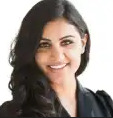
Contact Sonia Nijjar at Neinstein Personal Injury Lawyers


Read More
#Neinstein Personal Injury Lawyers#Toronto Personal Injury Attorneys#Greg Neinstein#auto accident lawyers
0 notes
Photo
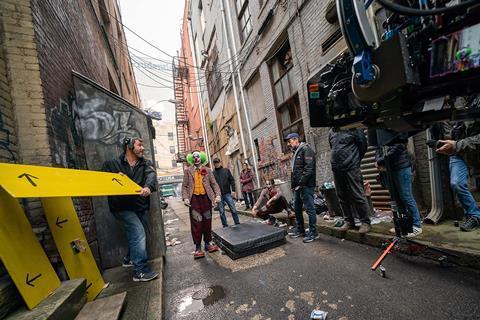
CINEMATOGRAPHY OSCAR NOMINEES ON AUTHENTICITY AND AVOIDING VFX https://ift.tt/2OZteQ0
The DoPs behind 1917, Joker, The Irishman, Once Upon A Time… In Hollywood and The Lighthouse reflect on the bold choices they made to bring dynamic visions to the screen.
Cinematographers are moving both forward and backward in technological terms this year, ironically in pursuit of the same goal: authenticity.
Avoiding VFX and instead opting to shoot reality has been a central theme. Robert Richardson used real Los Angeles backgrounds for the driving scenes in Quentin Tarantino’s Once Upon A Time… In Hollywood. Roger Deakins contended with real explosions and fires in Sam Mendes’s 1917.
Rigging equipment has also been a common talking point for DoPs in 2019. Deakins pushed the boundaries of stabilising devices to enable extended tracking shots for the continuous-take approach of 1917, while Papamichael explored the limits of large-format cameras, putting them in positions that would have been impossible a few years ago (on a low mounted arm attached to a racing car, in one case). Perhaps most complicated of all was Rodrigo Prieto’s “three-headed monster”, a three-camera set-up used to aid the CGI de-ageing process for Martin Scorsese’s The Irishman.
These and other top cinematographers no longer debate analogue versus digital, with plenty saying it is digital and film, rather than digital or film. This is in part due to rapid advances in camera technology by companies like Arri, with films including 1917 utilising a large-format digital camera that, according to Deakins, is as good as any film camera.
Mixing light sources has also been in vogue, with Lawrence Sher using harsh fluorescents and urban streetlamps to create the heightened eeriness of Joker and grittiness of the city.
Whether they are using old-school filmmaking techniques or the latest technology, these cinematographers are creating brave new worlds for audiences and their craft.
Lawrence Sher - Joker
SOURCE: NIKO TAVERNISE
LAWRENCE SHER ON THE ‘JOKER’ SET
Lawrence Sher has been known primarily for his work on comedies including Todd Phillips’ The Hangover trilogy, Paul, The Dictator and I Love You, Man, before he reunited with Phillips to create the dark, sinister world of Joker.
While Joaquin Phoenix’s performance threw up regular surprises during the shoot, Sher was a ready and willing partner for the award-winning actor, and says his own work plumbing the depths of the DC Comics arch villain — which won him Camerimage’s Golden Frog award in November — is not as big a departure as it initially appears.
What was the shooting schedule like for Joker?I read the script about a year before, did an early scout in March [2018] and then prepped for 10 weeks. The shoot lasted 60 days with one day of shooting lost due to issues with the LED lighting on the New York City subway sequence.
What was your approach to Joker’s colour scheme?My main colour palette was drawn first and foremost from real lighting fixtures that exist in the city. I also looked at movies of that era in which the movie takes place [1981], the colour of the film stock at the time and how it would capture all of this mixed light. The colour palette is a mix of utilitarian light and uncorrected fluorescents — we kept their crappy look so it wouldn’t be clean.
We changed out some of the streetlights so they would be sodium vapour, as opposed to LED which many streetlights are now. When we shot at dusk, you have that blueish light that mixes with the sodium vapours and suddenly you have the colours that I think people associate with the movie: the blues, greens, oranges and greys. You can see the messiness of the city.
How did you approach working with the actors to capture their performances?On set we maintain a certain rhythm for the actors. If they have to go back to trailer, even for 20 minutes, there is a momentum loss. So if I can shoot fast, they never have to leave the set. It helps everybody, especially the scene.
Todd Phillips encouraged improvisation, for instance the bathroom scene where Joker starts to dance after killing the men in the subway. Did that approach affect the shooting?That shot was improvisational. He was going to come into the bathroom, hide the gun, wash off the make-up and stand in the mirror and laugh. But with Todd, the movie is constantly being rewritten so you are discovering it as you make it. All of the planning is there but he’s always flexible. With that scene, he wanted to try it non-verbally. He played a piece of music — he didn’t tell the camera operator what was going to happen — and we got that scene in one take.
Was your approach to Joker different to your other films?My lighting approach is not any different. We are not servicing comedy [in Joker]. Some of the compositions come to the forefront perhaps, more than in my previous works. But my approach, particularly with Todd, is to allow for flexibility and freedom. A lot of it is co-ordination with production design and needing the freedom to be able to light a big space. To have the world lit as opposed to focused on a specific person on a mark.
Which sequence was the most challenging to shoot?The subway scene where he kills three Wall Street guys. We shot on a stage and with LED panels. It was challenging because while we had more money than other independent films, it’s still a budget issue. Todd had always described it as a fever dream — this kind of escalating light show. We accomplished it with a very expensive row of LED lights on both sides, though not too many LEDs because we tried to keep to the light as they had it in the 1970s and ’80s. I was taking the New York subway all the time and shooting with my iPhone to figure out the lighting for that scene.
How did you find working with Joaquin Phoenix?It was a transformative experience watching him act and getting to know him. I didn’t say anything to him during prep; he was a little bit intimidating. He apologised to me for acting weird and I said, “No man, do your thing.” We grew to have a good relationship, where we would challenge each other with the choices on set.
Rodrigo Prieto - The Irishman
SOURCE: NIKO TAVERNISE PICTURES
RODRIGO PRIETO WITH MARTIN SCORSESE ON THE SET OF ‘THE IRISHMAN’
Mexican cinematographer Rodrigo Prieto has worked alongside acclaimed directors including Alejandro Gonzalez Inarritu (21 Grams, Babel), Ang Lee (Brokeback Mountain) and Pedro Almodovar (Broken Embraces). The Irishman marks his third feature with Martin Scorsese, after The Wolf Of Wall Street and Silence.
Prieto describes the epic crime drama as one of his most challenging projects to date: an intensive 108-day shoot involving more than 300 set-ups, with the added challenge of managing a complicated CGI de-ageing process for the main actors, which incorporated a “three-headed monster” camera rig.
Although Martin Scorsese is an avid supporter of shooting on film, you had to use digital as well to achieve the de-ageing technique.Yes, 56% was shot on digital and 44% on film. The overall look I thought had to be based on film negative because of the memory aspect. Scorsese talked about home movies, this sensation of remembering the past through images, so I developed looks based on still photography, Kodachrome and Ektachrome.
For the visual effects, it was necessary to shoot with digital cameras where the face had to be replaced with CGI. Visual-effects supervisor Pablo Helman from Industrial Light & Magic needed three cameras synched for every angle and the shutters had to all be in perfect sync. The challenge of getting three cameras to move in unison meant that using film cameras from a practical standpoint was nearly impossible.
Was it Pablo Helman who came up with the idea of using CGI to de-age the actors?Yes, when we were shooting Silence, Pablo said he thought there was a way to make actors look younger through computer-generated imagery. He came up with a three-headed rig where the central camera, the Red Helium, is capturing the shot and two witness cameras, Arri Alexa Minis, are sat on either side of the main camera to read the infrared map of the actors’ faces. We called it the “three-headed monster”.
Can you talk about the stages of the de-ageing process and how that was achieved?There are several different stages. Prosthetics were used to make the actors look older. Make-up could make the actors look younger, for example making a 70-year-old actor look like they were in their 50s. VFX and CGI de-ageing were used when the actors are close to the transition to make-up, and that was complicated as the ageing transition was subtle, say, only a few months in time rather than several years. The technical and make-up teams had to be sure the transition was smooth.
How did you map out the visual arc of a film that spans five decades over three-and-a-half hours?We did not want to make it over-stylised or flashy. Scorsese wanted the camera to reflect the way Frank Sheeran [played by Robert De Niro] approached his job, which was simple, methodical and repetitive. The audience sees the same shots with Frank — the camera pans around at the same angle. When we were with other characters, like crazy Joe Gallo, the camera behaves differently.
How did the fact the film was made to screen first and foremost on Netflix affect the way it was shot?For the most part it wasn’t a consideration. Scorsese designs his shots in a way that helps the story. The one thing we did change was the aspect ratio. Normally, Scorsese would use widescreen but in this case we thought we had better use 1.85 because it would fill up home screens. It also fit Frank’s personality more, as well as helping to show the height difference between the characters. Frank was a tall man so we made special shoes for De Niro and boxes with cushions where he sat. For accuracy, we also changed his eye colour to blue.
You were working on a tight schedule. Was there any room for improvisation during the shoot?When the actors want to try something different, Scorsese will almost always go for it. Near the end of the film, Frank is looking as his car is being washed and it’s a defining moment. We lit the scene for him standing and always looking at the car. Then De Niro said, “I always kind of imagined being inside the car.” So Marty said, “Oh, OK, let’s do that.” I had to set it up in three seconds. As soon as we shot it, I could see that his performance was there.
Jarin Blaschke - The Lighthouse
SOURCE: CHRIS REARDON
JARIN BLASCHKE ON THE SET OF ‘THE LIGHTHOUSE’
Born in the Los Angeles suburbs, Jarin Blaschke continues a collaboration with filmmaker Robert Eggers that began on the latter’s 2008 short The Tell-Tale Heart and encompassed his haunting 2015 feature debut The Witch. For The Lighthouse, the pair conjured up another strange and foreboding world: a mysterious New England island in the 1890s, inhabited by lighthouse keepers Robert Pattinson and Willem Dafoe. Blaschke deployed innovative lighting and lensing solutions to take on not just the wilds of authentic Nova Scotia locations, but the demands of dark, cramped, wet settings.
How many years did it take to develop the concept of The Lighthouse?I didn’t have a script until a month or two before prep, but Rob first pitched this idea probably three years before that. With him, it starts with atmosphere, so my subconscious was working on the atmosphere at the same time that we were developing The Witch. We didn’t know which one would go [first] and then The Witch happened.
The Lighthouse was shot in black and white, with a 1.19:1 aspect ratio, on Kodak Double X 35mm film format, which dates from the 1950s. How much testing did you do?There was a battery of tests I put myself through, like testing real oil lamps to see how to do it with an electrical lamp. I had to know how to light differently: I bolstered the light levels by 15, sometimes 20 times, and the film stock had to be tested in rain, backlit to know where it looks like night but also doesn’t look overly lit.
What logistical challenges did you face shooting on location in Nova Scotia?The weather was bad and added about four days to our schedule. It could have been worse but we had a covered set. We couldn’t do a night scene one night because it was too windy and even with day scenes, you have frames where you need to bounce light back using a giant sail and it gets a little hairy. There was a lot of eating cold porridge in the dark in the morning and the breakfast tent was going to blow away. We had to build this hardcore tent just to have breakfast. It adds to the movie, I hope.
In exploring the space between reality and insanity in The Lighthouse, did you use special lenses for certain scenes?I went to Panavision. I know vintage lenses are really trendy right now. I had some experience with the usual suspects: Cooke Series 2s and Super Baltars [used in The Godfather and The Birds]. They put original Baltars in front of me and I fell in love with them. So we had old Baltars from the 1930s. We used the first high-speed portrait lens of the 19th century for special shots, like [Robert Pattinson] having sex with a mermaid, the hand going down the body. Stuff that was super heightened where we could get away with it.
How did your collaboration with Eggers inspire you for certain images?I’ve known Rob for 12 years so I knew there were going to be a lot of symmetrical two-shots. There is one direct reference to a Sascha Schneider painting. And the last scene in the film is in the lookbook. Those are the only two references, everything else I tried to create. I know Rob watched all kinds of crazy stuff, like videos with shark genitals.
You are also working on Eggers’ next film, The Northman. What can you say about it?Rob says very little. It’s a bigger movie than the others. I can say it’s a Viking revenge movie and we are shooting in Europe. I think he feels a responsibility to do a trilogy. It’s dark and unusually violent.
Robert Richardson - Once Upon A Time… In Hollywood
SOURCE: ANDREW COOPER
ROBERT RICHARDSON WITH QUENTIN TARANTINO
A nine-time Oscar nominee and three-time winner, Robert Richardson’s career has been closely associated with three filmmakers: Oliver Stone, Martin Scorsese and Quentin Tarantino. For Stone, he photographed 11 features in a little over a decade, winning the Oscar for JFK; two of his five collaborations with Scorsese brought him Oscar statuettes (The Aviator and Hugo); and he shared Camerimage’s director and cinematographer duo award with Tarantino for their work across six films including Once Upon A Time… In Hollywood. Richardson is known across the industry for pushing boundaries and doing whatever it takes to achieve a shot.
How would you typify your relationship with Quentin Tarantino?A relationship with a director is a marriage. I have been fortunate enough to forge a series of relationships with all of the directors I’ve worked with from the beginning. It’s the idea that you are linked together and begin to understand how the other speaks, what you like and don’t like. It’s so important. Collaboration at that level is why rock ‘n’ roll bands are the very best when they hold out and play together as the same team as long as they can. The Beatles wouldn’t have been who they were without John, Paul, George and Ringo.
What is your creative process like with Tarantino once you’ve read the script?Quentin was in the room when I first read the [Once Upon A Time… In Hollywood] script. It took me a substantial time to read it. After we had dinner, we made notes and then he played music: ‘Good Thing’ from Paul Revere & The Raiders, ‘Mrs Robinson’ from Simon & Garfunkel, ‘California Dreamin’ from Jose Feliciano. The soundtrack is like a character in the film; it leads you, it is continuously playing from a radio station. The music helped build on the emotion of the characters and the movement of the film.
What is Tarantino’s process for selecting shots?He only shoots on film, he only processes on film and he only watches dailies on film. He doesn’t see digital replication until he gets to the Avid in the editing room. Our process is to shoot a film chemically, process and print chemically, and that print is duplicated on a 35mm projector. You then project the film as well as the digital intermediate, and they need to replicate each other perfectly, otherwise Quentin doesn’t want to discuss it. It’s definitely challenging, but that’s how we get to be better artists.
And when filming, Tarantino always sits beside the camera?Quentin is a director not a selector. He sits beside the camera. There is no video village, there is no video replay. You don’t go back and look at something. He watches the actors and their performance. If he’s got it, it’s over. If there is an error, something happened or an actor needs a retake, he will listen to why, but he will always choose in the editorial process the very best performance. The film is golden in its use of warm, saturated colours. We wanted to make a film that was about California and sunshine. On my side, it’s a combination of film stock, lenses and light. For the golden exteriors, we used a combination of Panavision’s anamorphic lenses and golden lenses.
You are known for using myriad film stocks to achieve different looks. What did you use for this film?We shot 35mm anamorphic, except when shooting Rick Dalton’s western television series, then we were 35mm black and white, and we shot with spherical zooms mostly in 1.33. There were also two sequences at Sharon Tate and Roman Polanski’s home that we shot on Kodak Ektachrome, one in 16mm black and white and the other on Super8mm colour.
Roger Deakins - 1917
SOURCE: FRANÇOIS DUHAMEL/UNIVERSAL PICTURES AND DREAMWORKS PICTURES
ROGER DEAKINS ON THE SET OF ‘1917’
Winner of four Baftas and an Oscar (secured last year for Blade Runner 2049 on his 14th nomination), the prolific Deakins has been an influential figure in cinematography since he burst on to the scene with 1984. On that film he pioneered a bleach bypass process to achieve a washed-out look that went on to be used in films including Se7en and Saving Private Ryan. He has also been at the forefront of embracing digital filming methods, not least on Sam Mendes’s Skyfall.
He reunites with Mendes on 1917, which follows two soldiers on a mission to avert a strategic disaster during the First World War. Deakins and Mendes had to invent new ways to move the camera to create the impression that the narrative was unfolding in a single, continuous shot — an innovative feat that puts the audience on the frontline.
How did you achieve so much fluidity in single camera shooting?We used a lot of different rigs. Probably 60% of the film was shot on a stabilised remote head. Some shots are done on the Trinity [Arri stabiliser rig], some are done on the conventional Steadicam and there’s even a drone. But the majority of the film is done remotely with a stabilised head that’s either carried by the grips or a tracking vehicle on the end of a crane or on a wire.
How did you plan such incredible camera movement while keeping up the illusion of one continuous shot?Sometimes it’s put on to a wire and then moved, or it’s taken off the wire and then someone carries it or runs with it so it all becomes one shot. The reason was not only to sustain the scene but also that we didn’t want to cut in some of the obvious places.
Were you pushing the existing technology, or did you have to create new methods?We created some of our own. For instance, running with speed down a trench in front of two characters like we were, you can’t do that on Steadicam. So a Steadicam operator came up with the design of little mini-posts with gyros on them, and we put a very small remote head on top. He would run down the trench facing forward with the camera facing backwards over his shoulder, which I was remotely operating. Then he’d get to a corner in the trench and segue around so he started on a front shot.
How did you communicate with the operating team on the ground?I’d be operating remotely. I don’t like wearing earphones because I’m constantly running to and from the set talking to grips or whoever. James [Deakins’ wife and digital workflow consultant] would be on set wearing earphones and relaying messages to the crew. During a shot, she would say things to the operating team like “faster, faster” or “you are getting too close, a little to the left”. It helped because they couldn’t see what the camera was seeing.
How integral were the four months of rehearsals?The trick was for Sam and me to figure out what we wanted to do: where we wanted the camera and to finesse the camera moves relative to the actors. We tested specific rigs on specific kinds of shots. That was the big trick, really, practising with different pieces of equipment. We also went to Salisbury Plain and mapped out all the shots we wanted before anything was dug or built, such as the farmhouse.
How was the weather integral to the film?Being such an exterior movie, we were very dependent on the light and the weather. And we realised you can’t really light it. If you were running down a trench and turning around 360 degrees, there’s nowhere to put a light. Because we were shooting in story order, we had to shoot in cloud to get the continuity from scene to scene. Some mornings the sun would be out and we couldn’t shoot so we would rehearse instead.
The shooting in 1917 had to be in sync with the editing. How did that process work?Sam had to choose the take he wanted before we did the next shot because we had to match them, like the beginning of the B side had to match the end of the A side. That frame and the camera movement and the position of the actors had to match exactly. We would have the take on playback, and set up the incoming take and keep playing the beginning to match the end of the shot. That’s the great thing about video assist and being able to overlay the two images.
You were one of the early adopters of digital shooting. What won you over?
The Arri Alexa tipped the point for me between film and digital. I find it a bit of a non-argument. I think it’s what’s in the frame and where you point the camera.
0 notes
Text
LUCAS BLALOCK: SEEING THINGS APART
The past ten years have seen a growing interest in the materiality of photographs and how digital technology has changed the way they are understood and interpreted. Photography’s ability to bridge and/or function as painting, sculpture and other art forms has become increasingly apparent in the work of photo-based artists like Lucas Blalock, Sara Cwynar, Sam Falls, John Houck, Jessica Eaton, Michele Abeles, Artie Vierkant, Daniel Gordon, Kate Steciw, and countless others. Whether or not these artists actively identify their participation in a particularly new “movement” in photographic history, their work is linked – at the very least, superficially – by a whimsical, yet controlled approach to dissect and reexamine the physical and conceptual potential of the medium in an increasingly digital age.
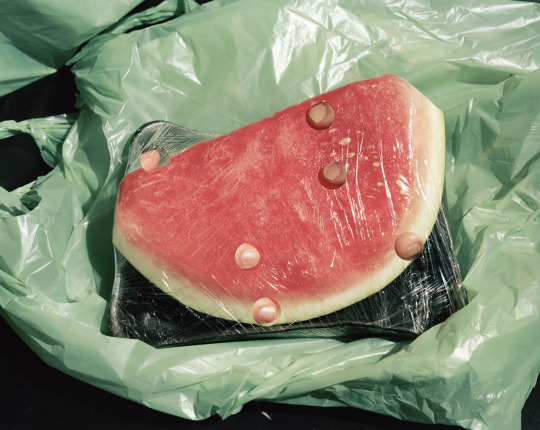
A Physical Feeling, 2014. © Lucas Blalock
Lucas Blalock, whose work will be included in the Museum of Modern Art’s New Photography exhibition this fall, is often considered to be a leading artist in this moment, and has been at the forefront of pushing its limits. He is frequently and internationally exhibited, widely acclaimed, collected, and often copied by younger, so-called “post-digital” generations of photographers. This is particularly visible in countless submissions of emerging photography that I review each year for Humble Arts Foundation’s open calls, and various other exhibitions and competitions I regularly jury. Like his contemporaries, Blalock’s work dissects the current state of the medium, its history, and in many ways its relationship to painting and sculpture. While once photo-based artists like Kate Steciw and Sam Falls have expanded their practice to engage with painting directly, Blalock’s uniqueness lies in his utilization of digital tools. Whether used for sculptural or painterly purposes, they remain entirely rooted in photography.

Cactus Action, 2013. © Lucas Blalock
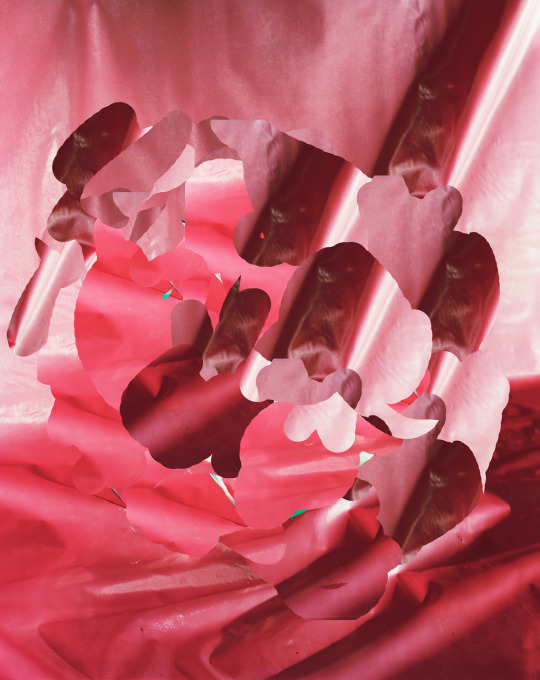
This That, 2013 ©Lucas Blalock
When Blalock graduated from Bard College in 2002, the photographic landscape was significantly different than it is today. Stephen Shore had just recently begun to embrace digital technology – mainly to preserve his fading 1970’s color negatives – and online discourse on photography was limited to a handful of blogs. Analog printing was still a technical staple of art photography programs, and much of the work coming out of Bard, Yale and SVA, including Lucas,’ was remarkably influenced by photographers like Jeff Wall, Gregory Crewdson and Philip Lorca di Corcia.
One of Blalock’s early professors, Vik Muniz, who he assisted for a few years after graduating, challenged him to think more deeply about why he was photographing this way. Often staged, Blalock’s early, cinematically inspired images included somber nocturnal scenes, low-lit hotel and gas station narratives, and stills that could have been straight out of the movie American Beauty. “I was still very much thinking through cinema as a model for photography at that point,” says Blalock. "When I was at Bard, Vik Muniz asked me – at a time when I was making really narrative pictures –whose point of view were we looking through? Was the camera a character? I remember this bowling me over at the time – I just hadn’t thought about it.”
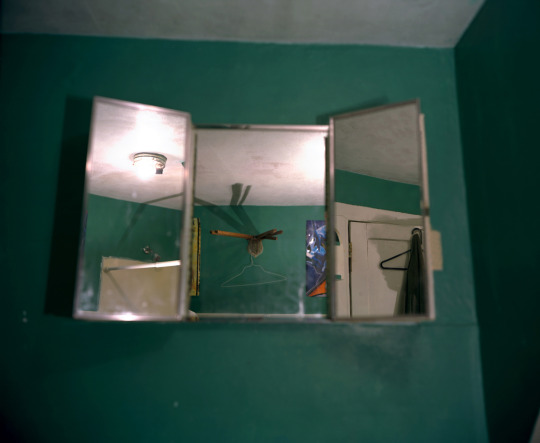
Early Work © Lucas Blalock
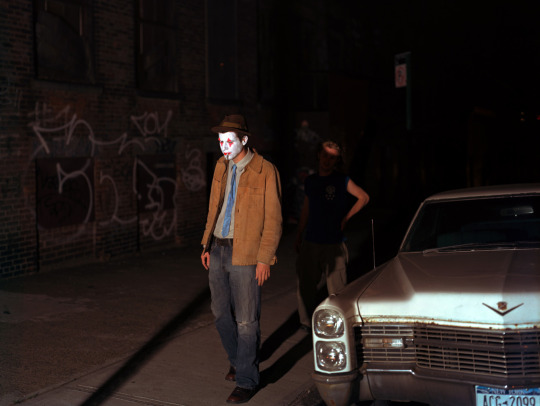
Early Work © Lucas Blalock
The prominence of these traditions, combined with the recent emergence of digital technology may have sparked a reaction in Blalock and his contemporaries. In an interview with Carmen Winant for the March, 2013 issue of Frieze, Blalock described photography as being in an “insecure” moment, which he sees as having transitioned from tableaux to a “push to sort out the information in the picture, and also the information the picture itself is made of…” (Winant, Carmen. Frieze no 153. March, 2013). Muniz’s challenge, and this generally insecure period, helped to push Blalock’s work into new territories in the years following his time at Bard. He transitioned from borrowing its cinematic tendencies to something that examines how we, as viewers, “look” at images.
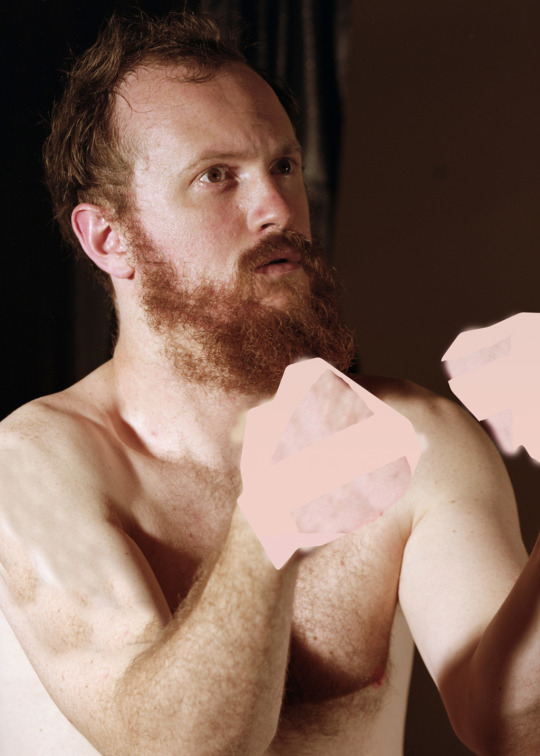
The Contender, 2009. © Lucas Blalock
“I think the work took on its current course after I read Moby Dick in 2007, which got me really interested in the 19th century, and I started to think a lot more through painting and historical photography.”
Similarly, the relationships he built as an undergraduate at Bard helped to foster a new discussion in his work and reading of contemporary photographers who would help to shape this new vision when he moved to NYC a few years after graduating.
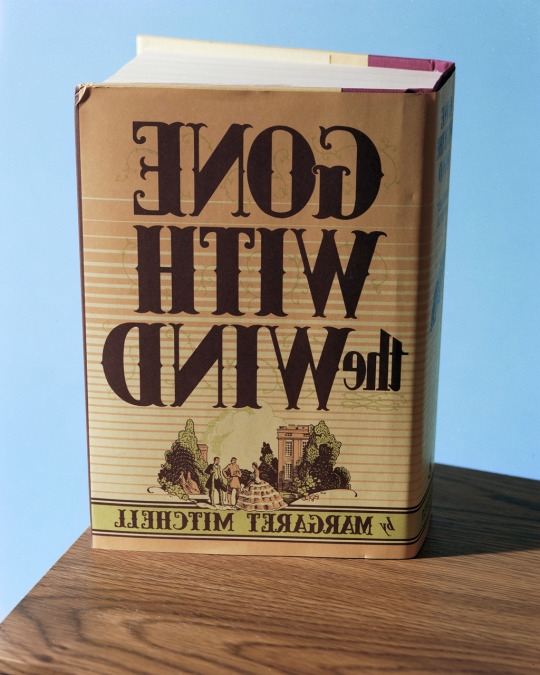
Gone With The Wind, 2009 © Lucas Blalock
“I moved to NYC that summer and spent a lot of time in my friend, and fellow photographer, Barney Kulok’s apartment looking at books. He has a pretty tremendous library. Roe Etheridge’s Rockaway book and Christopher Williams’ shows at David Zwirner were also really important for me to see, as was the 2008 Courbet show at the Met. His paintings can be so weird. Young Ladies on the Bank of the Seine, for example, has these bodies that are so distorted and strange if you really look at them."
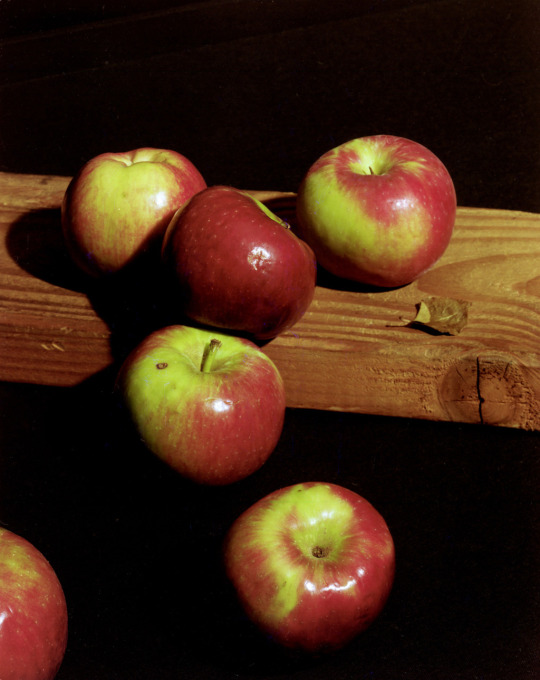
Apples and Wood, 2009 © Lucas Blalock
Whether or not this shift was a conscious reaction to the canon of photographers dominating grad school curriculum, the onslaught of digital technology, or the dramatic change in how images were shared online, this pivotal point – which Blalock cites as starting around 2007 when he moved to NYC – is most apparent in his first book I believe You Liar, published by his own imprint Iceberg Iceberg Iceberg.
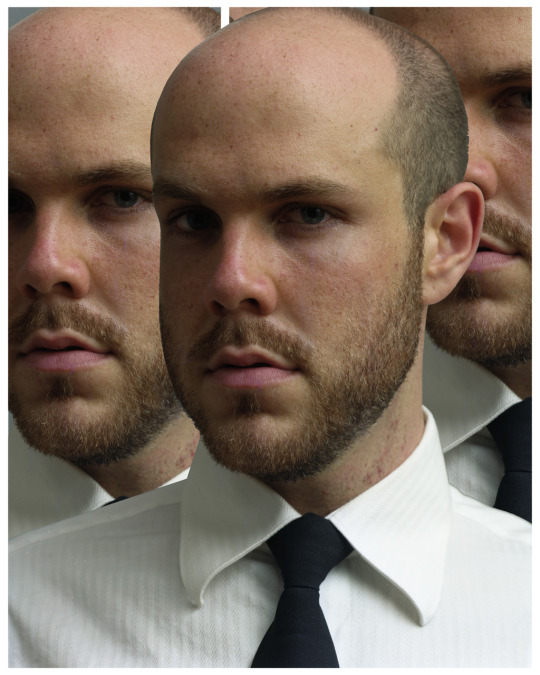
Joshes, 2008, ©Lucas Blalock
This eight inch square paperback of mostly in-between gestures, deadpan observations, quiet portraits, landscapes and architectural details might seem like a soft moment of pause following his early narrative leanings. However, the early traces of his experimentations with digital technology and accident are also scattered throughout. Cydney v. 2, 2008, for example is a digital sandwiching of 5-6 negatives, shot in profile view on film, and then scanned together, resulting in an image that replicates an in-camera multiple exposure, or technical accident. Joshes, 2008 duplicates the same portrait multiple times, and was one of Blalock’s first instances of what he describes point blank as “fucking with Photoshop.”
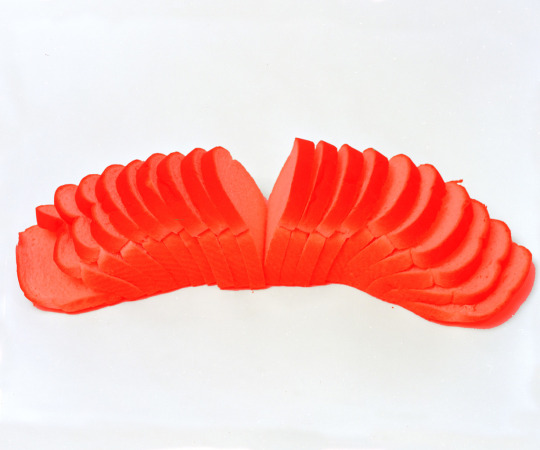
WMTMMBM, 2011 © Lucas Blalock
“I had first experimented with this at Bard, but at that point I couldn’t resolve the actual reasons for it. It was with this work, starting around 2008, that it took real shape, and it started by making pictures in Photoshop that mirrored darkroom processes or are confusable for analog procedures.”
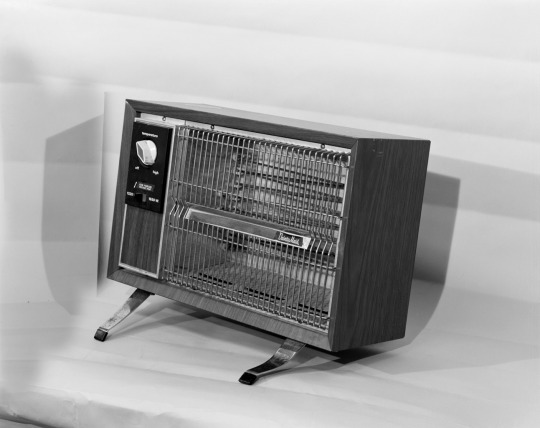
Heater, 2011 © Lucas Blalock
Blalock soon began to rapidly move into heavy experimentation with Photoshop, and a process that involves what he describes as a “twofold process of picture making.” Like his earlier work, he continued shooting all images on film with a large format view camera. However, Blalock started scanning them, sometimes placing multiple negatives in the scanner at once, using Photoshop to give them new dimension. While this might be commercially described as “post production,” for Blalock, it’s more about using these devices, like paintbrushes, as an additional layer to his artistic process.
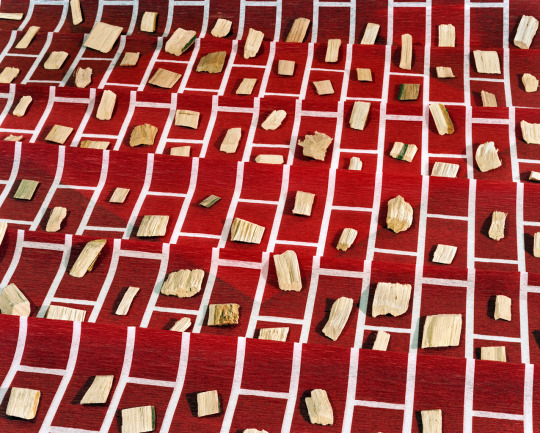
Building Materials, 2011 © Lucas Blalock
“When I get my film back a few days later there is the possibility of continuing that picture making. The computer is applied to all of the pictures – sometimes it is ‘grooming’ and other times it is much more active.”
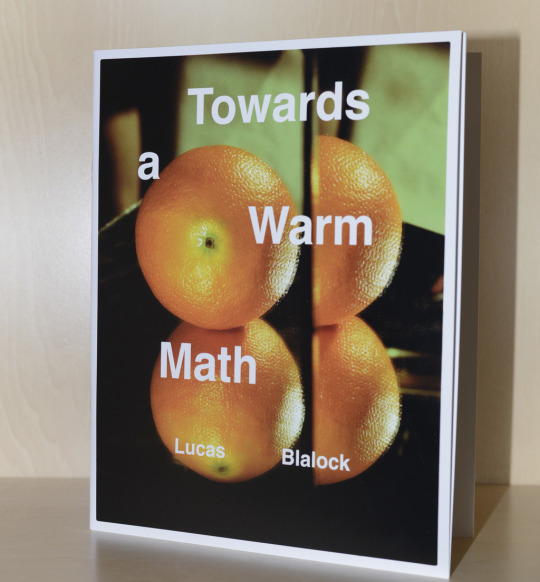
Going beyond his earlier multiple exposures, Blalock’s work developed into a playful exploitation of some of Photoshop’s most basic tools. Much of the work in his second book, Towards a Warm Math (Hassla Books, 2011) employ heavy use of the clone stamp, which he uses not as a method for retouching, but as a paint brush to create visual distortions, and to confuse perspective. The work – mostly banal still-lifes contorted in Photoshop – encourages the viewer to look beyond the material of what is being photographed, and toward the viewing experience itself.
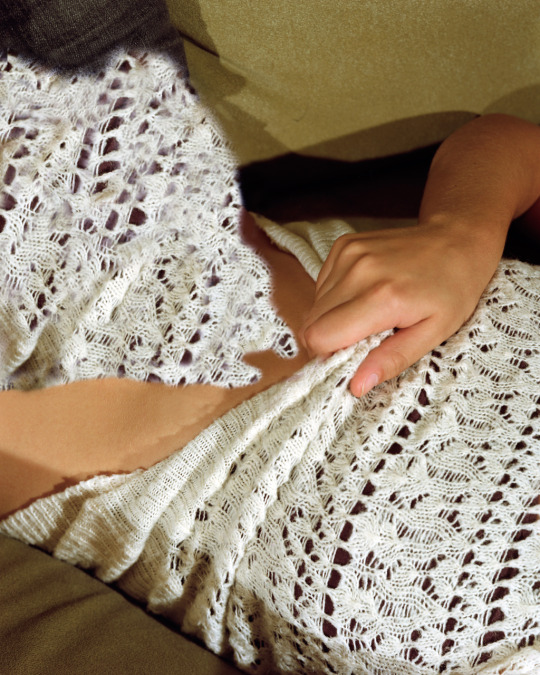
Untitled (Dirty Pun), 2009. ©Lucas Blalock
The book’s opening photo Untitled, Dirty Pun, 2009 depicts a hand pulling a blanket, or possibly a sweater, off of a figure to expose traces of mysterious skin. It’s unclear whether this is someone’s midriff, or another area of his or her body as much of the fabric has been cloned out and smudged. As viewers, we’re not sure exactly where to look, but we can sense a kind of unveiling, a gesture that might serve as a larger metaphor for uncovering the world we are accustomed to seeing in pictures.
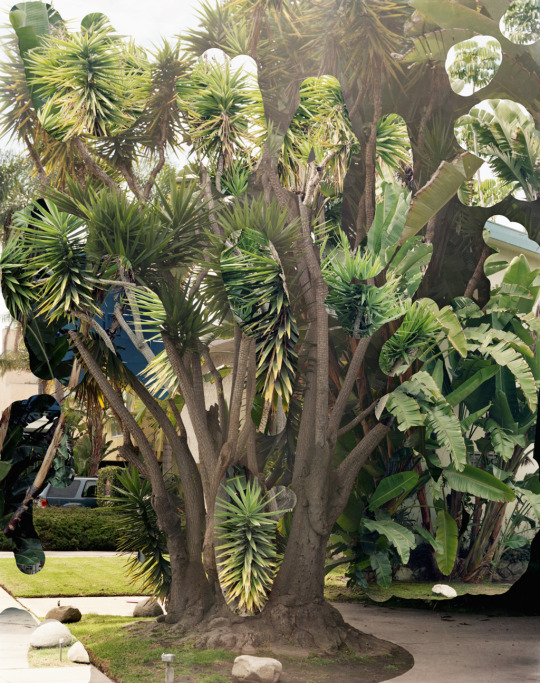
Tree on Keystone, 2012 © Lucas Blalock
Through a disconcerting process, this jagged, and sometimes intentionally failed-looking use of Photoshop serves as a means of exposing and undermining the presence of such tools in commercial photography. While the clone stamp and other tools are often used commercially for retouching, Blalock uses them to create transparency about the images and how they are commonly produced. For Blalock, this parallels playwright Berthold Brecht’s ideas of the “Alienation Effect.” In many of his plays, Brecht used the theater to break down what he saw as distance between performers and audience members, inserted stage directions and traditionally hidden acting cues into the actual stage performances. Just as Brecht once made his stage directions transparent to his audience, Blalock now uses intentionally faulty editing techniques to expose photography’s digital process to his viewers.
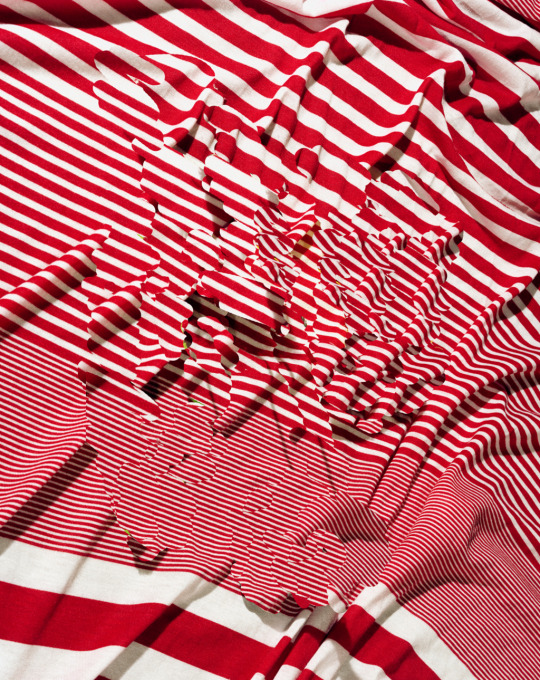
Accurate Walking, 2012 © Lucas Blalock
“I felt like something similar was available in photography. Photography was also a naturalized presentation made in part by an invisible machinery, or at least a machinery that we had tacitly agreed not to see”
This idea took off in his 2013 book Windows, Mirrors, Tabletops, published by Morel. The title of the book was a riff on John Szarkowski’s 1978 Mirrors and Windows exhibition at MOMA, and the neon that read “Windows, Mirrors, Tabletops” from a glass store Lucas frequently drove by when he was living in Los Angeles.
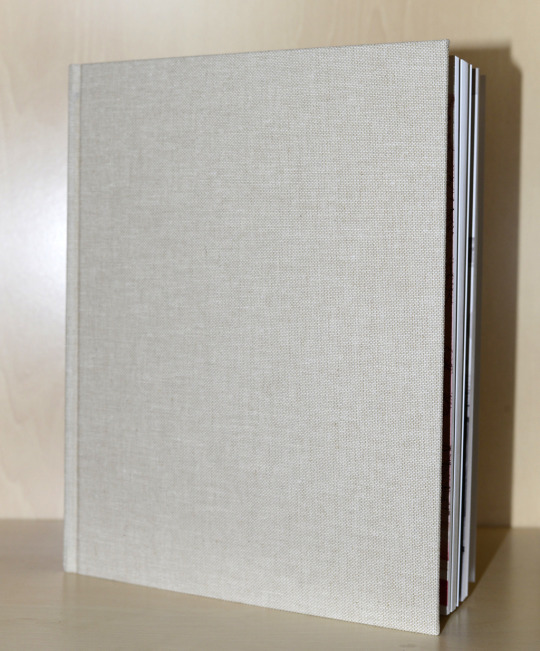
“I smiled the first time I noticed it, but over time I started to try and think this new term through photography and Szarkowski’s language. I thought about the computer’s desktop, Photoshop layers, and the still life table but it never really set down to any kind of fixed meaning. I liked the feeling though, that it wasn’t totally presumptuous to think about a new term. At least in some ways things have changed a lot”
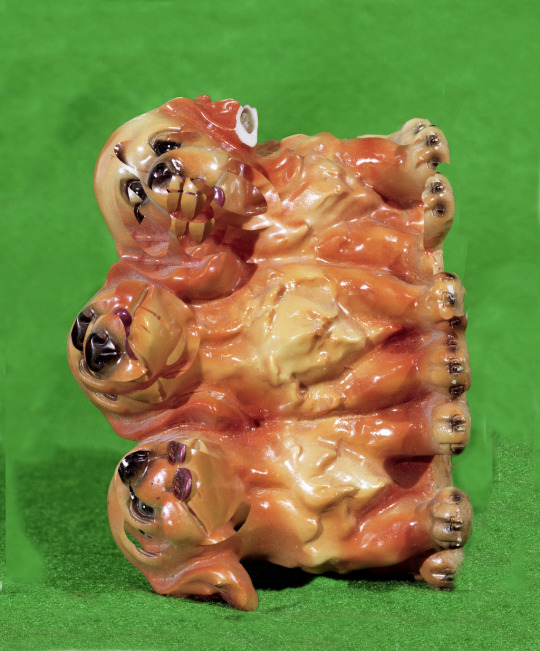
Still Life With Puppies, 2012 © Lucas Blalock
Windows, Mirrors, Tabletops includes imagery that is sometimes grotesque, often abstract, and, in its most sophisticated ways, subtly disconcerting to the eye. In the image Still Life with Three Puppies, 2011 Blalock photographs a dollar-store ceramic dog tchotchke on its side in front of a cheap green tarp backdrop. After scanning the negative, he shoddily morphs it into a Siamese triplet. The lighting is harsh and snapshot-like, and any attempts to “clean up” the background with the clone stamp are intentionally botched. Like Blalock’s other work, the picture is less about the dogs, the backdrop, or even the monstrous new form he has created, but instead raises the question about what it means as a fully formed picture, and how we as viewers choose, or are conditioned to look at it.
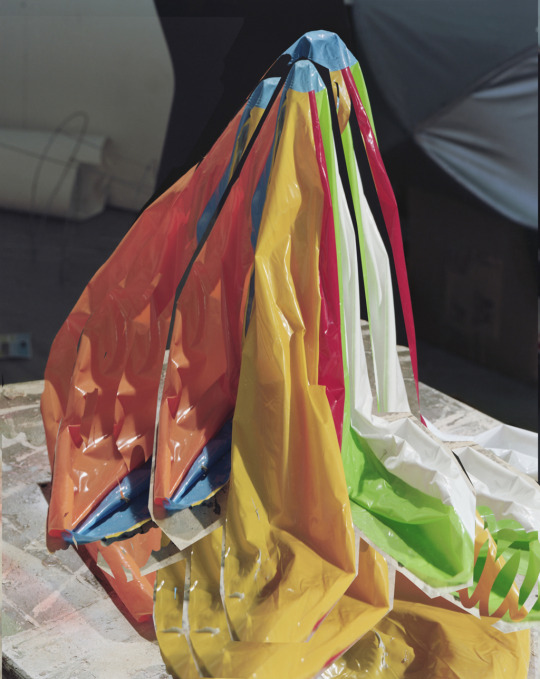
Tenting, 2011 © Lucas Blalock
Tenting, 2011 turns pieces of deflated balloons, newspaper and streamers into a strange, hovering, paper machete-like sculpture sitting dead center in the frame. While this new colorful beast may be the main focal point, studio objects the background of the photo clue the viewer into the photographic mechanics that are so central to his work. On one side, a rolled up studio backdrop sits in the corner of the room, while a studio reflector juts into the background on the right side of the frame. This is one of few images with a specific, literal reference to the photo studio as a part of the photographic process. They exist more as visual footnotes uncovering layers of digital and analog secrets.
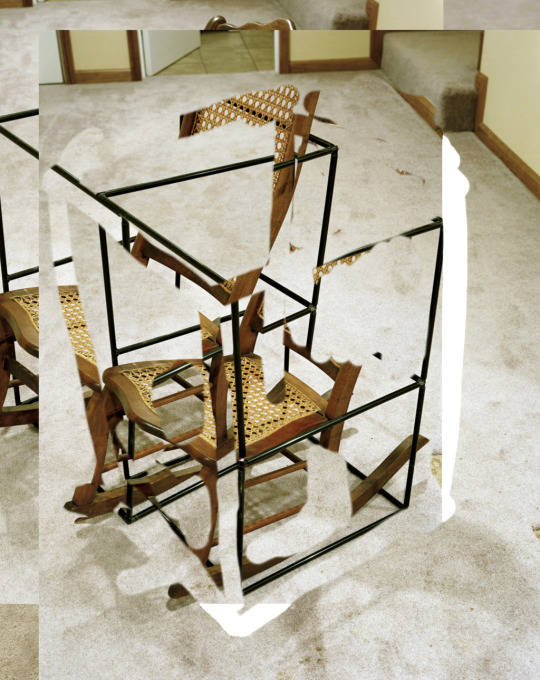
Rocking Chair, 2012 © Lucas Blalock
In Rocking Chair, 2012 multiple negatives of a wicker chair are layered on top of one another, blurred, cloned and erased at random points with digital slices cut in certain areas. Perspective flattens into a two-dimensional sculpture that, despite its absolute and seemingly random chaos, feels somehow resolved. This carefully placed randomness feels like x ray goggles that Lucas has handed us as a lens for seeing the every day in a visionary new way.
img116, one of the subtlest images in Windows, Mirrors, Tabletops initially appears to be a straightforward photograph of a paint splotched highway underpass. At first glance, the image resembles a straight photograph of Rothko-inspired abstractions that often result when city officials attempt to cover up graffiti in public areas. At a closer look, it’s clear that these are actually quiet variations of Blalock’s pranks, which create both the illusion of paint on the walls, and an uncomfortable flattening of space. On the area where the overpass meets the ground, the remains of a clone stamp faintly appear, like fingerprints whispering “Lucas Wuz Here.”
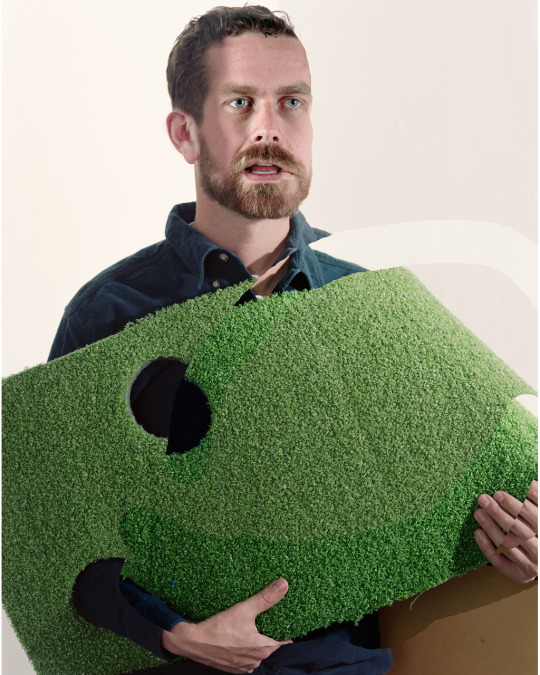
The Guitar Player, 2013 © Lucas Blalock
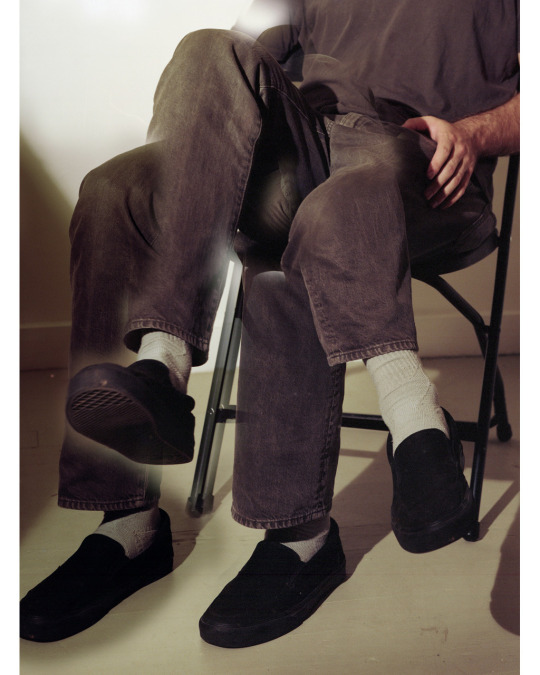
Tom’s Legs, 2013 © Lucas Blalock
As controversy continues to arise regarding overly airbrushed models in major fashion magazines, and Instagram tools have democratized retouching for the masses, it’s interesting to consider Blalock’s work as one that challenges, exposes, and plays with these mechanics. The title of his first and most straightforward book, I Believe You, Liar might actually be an unintentional precursor to the questions raised in his more recent work. Since the publication of Windows, Mirrors, Tabletops, largely in response to the immense popularity of Instagram filters that democratized the ability to “fuck with Photoshop,” Blalock’s work has taken a more direct turn. While still pulling apart the mediums deceptive seams, it’s no longer entirely reliant on playing with photography’s digital tools to make its commentary. “Before I was using the procedural steps in commercial picture making as a skeleton to hang things on,” says Blalock, “where now I feel like I am more likely to see it as trying to get closer to the sense of the thing pictured.”
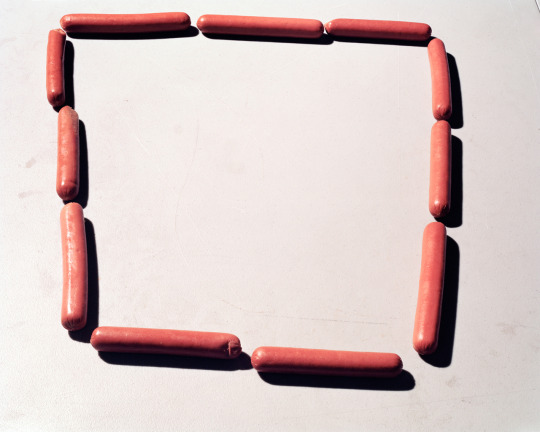
Hotdog Box, 2014 © Lucas Blalock
Blalock’s consciously crude applications show the unavoidable artifice that may exist in all photographs, and reveals them as cheap and superficial. His specific subject matter is not central to his final photographs—whether they are landscapes, portraits, a bowl of fruit, random objects purchased at a dollar store. Even his straightforwardly jarring, flash-blasted images of hot dogs hinge on the process of controlled looking. Ultimately, it pulls the viewer from a fantastical, polished world, into one that wears its flaws on its sleeve.
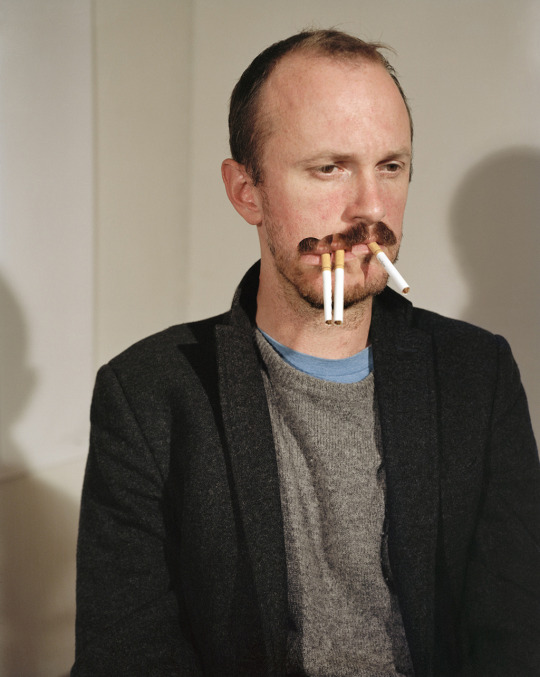
The Smoker © Lucas Blalock
Source
0 notes
Text
Wellesley in Art: Interview with Tina Romero '06 a.k.a. DJ TRx

(Tina Romero. Photo by Amber Gress.)
Tina Romero ‘06 is a filmmaker, DJ and dancer living in Brooklyn, New York. At Wellesley, Tina was a double major in Cinema and Media Studies and French. She was also an active member of the dance and theater community. In 2006 Tina moved to NYC to attend NYU’s Tisch School of the Arts Graduate Film program, where she received an MFA in Film Production. She has written and directed several short films and music videos. Her film, “Rainbowarrior” was shot at Wellesley and featured Wellesley students and alums. She also DJ’s all over Brooklyn and New York City. DJ TRx (pronounced “trix”) spins regularly at Hot Rabbit and Bad Habit, parties created by fellow alum Emily Hall Smith ‘06. She even DJ’d at Wellesley for her 10 year reunion in June 2016! In addition to creating her own films and DJ-ing, Tina teaches students both in the US and abroad about film and photography. A true renaissance woman, we are thrilled to get a chance to talk to Tina!
WU: We are so excited to interview you, Tina! You are truly a polyglot in the world of art as a DJ, filmmaker and writer, professor, and dancer. Where did your interest in these areas of art first begin?
Both of my parents are artists, which meant neither of them wanted me to become an artist. Nevertheless, they always supported my creative "endeavors," be it sitting patiently through an epic, plot-free fairytale performance piece in our living room or helping me make a video letter to a far away friend. When my dad wasn't working, he would unwind with crafting, puzzles, magic tricks, music, and I would join him. Of all the things my dad and I did together, what inspired me most was the experience of watching movies with him. My dad would weep when we watched films—not at the sad endings, but at the opening notes of a film score he found perfect, or as the camera swept through the choreography of West Side Story. He showed me that movies can move people, that fictional people can stir real-life empathy, that made-up worlds tell us about the essence of being human. I can’t remember a precise moment of realizing I wanted to be a filmmaker, but I knew even as a child that my goal was to move people.
WU: You were a Cinema and Media Studies major at Wellesley and went on to get your M.F.A. from NYU’s Tisch School of the Arts in Film Production. How does your educational background help and inform your work?
Well, I can't see myself cozying up to a blanket and a bowl of popcorn for a Friday night viewing of "Birth of a Nation," so I'm grateful Professor Viano screened it in CAMS 101. It was a gift to be guided through film history in slow, thoughtful steps.
Nowadays we have all this digital gear at our fingertips when we shoot a movie, but a fancy camera doesn't necessarily make a good movie. Looking back at pre-CGI (computer generated imagery) movie magic is inspirational, especially when working with a small budget. With strong content and execution, you can do a lot with the basics.
Writing numerous analytical essays on movies certainly taught me to be thoughtful about the details; to ask myself how to enhance thematic ideas using mise-en-scène. Film school, on the other hand, showed me that nothing goes the way you plan it and to roll with the punches.
WU: Your short film, Rainbowarrior, premiered at the Melbourne International Film Festival in 2009. It’s a silent film for the most part and portrays a class of school girls under the thumb of a stringent headmistress (with a penchant for leather bustiers/corsets). One student craves color, music, and movement but is reprimanded for seeking these things out. Tell us about the film and the inspiration behind it.
I started NYU the fall after I graduated from Wellesley and the transition was...shocking. At Wellesley, if I left my backpack on a Severance commons couch, it would still be there three days later. Within a month of moving to Brooklyn, someone stole my laptop bag from a bar. Surviving my first year of grad school AND the avalanche of adult responsibilities that I didn't see coming was overwhelming. I remember thinking nothing will ever be as good as Wellesley. I was anxious, existential and going through a bad breakup. But I was also determined to take control of my life. This is the headspace from which Rainbowarrior was born. To me, the film is about a revolution of spirit and how inner strength can spark change in others.

(On the set of Rainbowarrior in Founders Hall. Photo by Jonathan Young.)
The first images marinated in my mind to the tune of a song called "Rainbowarrior," by Coco Rosie. I knew I wanted the film to be dialogue-free and feature movement/dance. I could picture the world, but I struggled to get my ideas down on paper, so I set up an emergency meeting with Amy Fox, a writing professor I trusted deeply. She encouraged me to lean into the images in my head no matter how weird or non-narrative. (This meeting happened to take place on the same night Amy's family brought home Leah, a German Sheppard mix with a shitty past. Leah and I were instant buds. I dog-sat, took her on camping trips, used her as flirt bait in the summertime…) With Amy's encouragement, I eventually had a script. Thanks to Wellesley, my family, and a magical cast & crew, I was able to bring it to life.
WU: In addition to the film Rainbowarrior, several of your works involve our alma mater, alums, and students. Soon after your graduation in 2006, you returned to Wellesley as a guest choreographer for Wellesley College Dancers. You choreographed high school musicals at Automotive High School in Brooklyn alongside Wellesley alum Julia Duncheon ‘06 and brought students to perform at Wellesley in the group FreeStyle’s annual JOI (“JAM ON IT”) Fundraiser. How and why does Wellesley serve as an inspiration to you? What activities and experiences at Wellesley inspired you the most?
I got involved in the dance community as soon as I got to Wellesley. I was a dedicated member of both FreeStyle and Wellesley College Dancers throughout my time there. In both groups, I had the opportunity to choreograph a new dance piece every semester. Because I have an affinity for spectacle, I always packed as many dancers as I could into my choreography. I did numbers featuring roller skaters, fog machines, flashlights....even Campus Po made an appearance at the end of my "Thriller" piece. I think it's safe to say that no one goes to Wellesley College to pursue a career as a dancer (I didn't expect any of this to be a part of my college experience). There was no cut-throat application process to be a choreographer because there simply weren't that many of us doing it. As a result, I could play with the big ideas I had.

(Julia Duncheon, Bethany Winkels & Tina Romero (all class of ‘06) moved from the short hall Shafer to 16th Street in Brooklyn, NY. Photo by Photobooth.)
One Winter-Session, I stayed on campus to choreograph the musical, "Into the Woods." Luckily my friend, Bette, was also on campus, taking math, so when our friend, Julia decided to stay too, it was a party. Little did she expect to be cast as Rapunzel in the musical...I giggle every time I think about her in that wig. That same Wintersession I also taught an intro level hip hop dance class to a few of the professors who were on campus and interested in learning.
I also participated in Ken Loewit's theater work study. In addition to keeping up with general maintenance in Alumnae Hall and the Ruth Nagel Jones (RNJ) black box theater, we also assisted with whatever set build was happening. Ken taught me how to use a drill, which has turned out to be one of the most life-applicable skills I learned during College.
Everything came together my senior year during an independent study I did with Nora Hussey. I created a show called "Move This," which was my first foray into something I call "aesthetic storytelling". "Move This" was an intimate theatrical dance show in the RNJ. There was no dialogue, no character names, no particular setting. I wanted to evoke a sense of the emotional journey in the audience using lights, music, color, and movement. "Move This" is still my favorite project I've ever created. I'll never forget the way Nora supported me and championed my experimentation with the fusion of dance and theater.
I spent a lot of time in Alumnae Hall. It was a safe and creative space for me. I used to go to the ballroom late at night, put music on and dance my heart out until I had my next idea. It was heaven. Wellesley made it possible for me to create so much over my four years there, which shaped my ability to work with people and honed my voice as a director.
WU: Most recently you have been collaborating with the band, Shirley House, filming, editing and directing their music videos. How did the collaboration come into being?
Emily Hall Smith ('06), master party promoter and one of my closest friends in the world, connected us. Emily has always been one my biggest supporters - she never missed a WCD or Freestyle performance. Because Emily knows me and my work so well, she knows when a project is right for me. Needless to say, I clicked instantly with Shirley House and their music.
Fun story: when I shot my first film at NYU, Little Girl Blue, Emily carried 25 red balloons through the subway- one of those things that's more challenging than it sounds- and delivered them to our set.
Check out some of the videos Tina directed for Shirley house here and here.
WU: What is the difference between working on a film versus a music video? Is there one you enjoy more?
I feel in my element when I’m making a music video. The process of conceptualizing a music video is easier for me than writing a narrative screenplay. Ideas about movement, style, color and light flow much more freely from my head to the paper than those about than plot, conflict, dialogue, etc.
I also enjoy shooting to playback music (vs.shooting scenes with dialogue or live sound FX). Not only is it useful to have the option of directing aloud during a take, but it's also fun to play with the way a track can impact the vibe on set. I’ve often used music on set to shape the mood of a scene.
WU: You have also been writing a screenplay for the film, “The Lost Girls,” which is currently in pre-production. Tell us about the film, what it’s about, and when you find time to write!?
Finding time to write is a struggle. If I have stuff scheduled later in the day, I have a hard time getting into a good flow. I write best when I do marathon sessions- big chunks of time when I step away from the constant interruptions of today’s real world. I call my iPhone a tiny distraction box - it’s amazing how much more I accomplish when I turn it off.
I’m working on the “articulation of my creative process,” as my therapist calls it. Creating a routine based on what works best for me rather than what Lifehacker says I should try. I’m not a morning person- I’ve tried to force myself into a morning writing routine time and again, but it never works for me. It’s not easy, and I’m still exploring how to most effectively “set myself up for success”.
Writing doesn’t always happen on screen or paper. I’m “writing” in my head all the time. Riding the subway, doing laundry, dancing at a party. Embracing this has been essential to the continued improvement of “The Lost Girls”.
With respect to the film itself, I can’t give away too much about my feature, so I'll leave you with this:
“The Lost Girls” is a contemporary, queer take on Peter Pan. It’s a story about Wyn Kelly, a melancholy teenager, who runs away with a renegade girl gang, and learns how to embrace the challenge of growing up with newfound courage. “The Lost Girls” is an updated fairy tale- instead of pixie dust, they take ecstasy; instead of flying past Big Ben, they ride pink motorcycles.

(DJ TRx at the Rock Shop in Brooklyn, NY, moments after hearing the news of Emily Smith-Maresca’s (‘06) engagement to her fiancé, Nina. Photograph by Grace Chu.)
WU: As we mentioned in your introduction, you are not only a filmmaker and dancer but you also DJ! When and how did you first begin DJ-ing in Brooklyn and New York City?
I woke up one day and decided to go for it. I had a gut feeling it would be something I’d love. I took a couple of lessons and started doing house parties for tips, and things took off from there.
WU: Do you have a favorite venue?
Recently, I’ve been obsessed with everything that happens at The McKittrick Hotel, home to the immersive choose-your-own-adventure-style show, ‘Sleep No More’. The venue has two bars, a restaurant, and a ballroom. Every month, the creative team hosts an epic themed party - coming up is the May Fair Masquerade, advertised as “one night of surreal, decadent, costumed revelry.” One of my aspirations in 2017 is to be a guest DJ at one of their big soirees.
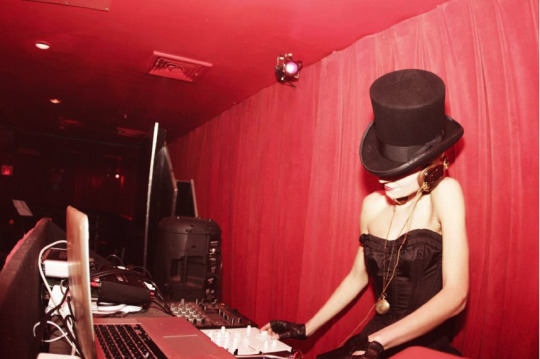
(DJ TRx at The Manderlay Bar in The McKittrick Hotel. Photo by Giselle Peters.)
WU: You even DJ’d at your 10 year Wellesley reunion! What was that experience like?
The thought of DJing didn’t occur to me until a few weeks before reunion so it was too late to schedule it into the weekend officially. I decided to throw my gear in the car and figure it out guerilla-style once I got there.
Our class dinner was on the Wellesley College Club lawn, which was the perfect spot to set up a pop-up dance party. I tracked down some available speakers, Campus Po lent me some extension cords, the dinner catering team hooked me up with a table, and we pulled it off.
It was such a highlight for me.
I was thrilled to contribute to the weekend in this way, and it was particularly special spinning for my Wellesley girls. We went hard on throwbacks.

(DJ TRx spinning Fiona Olamina (‘07) & Jonathan Trimby’s wedding at the Wellesley College Club. Photo by Marika Litz.)
WU: In 2011, you co-founded a Confession, a monthly queer dance party in Park Slope. What led to you starting Confession?
Rainbowarrior, in fact! Margaret O’Connor, who plays Headmistress Cursula, connected me to her husband, Scott O’Connor. He’d just become a co-owner of a new bar called, Mission Dolores, in Brooklyn and invited me to start a queer monthly party. Knowing I needed an event planner I brought Emily Smith on as the promoter. Inspired by the bar’s namesake, we called the party Confession and had a confession box that I pulled anonymous submissions from and read aloud throughout the night.
WU: Why do you think it’s important to have queer spaces like Confession?
This has been on my mind lately. After Confession, Emily went on to create Hot Rabbit, a weekly queer party in Manhattan. HR quickly became a staple of queer nightlife, and now Emily hosts Bad Habit, a bi-monthly spin-off party in Brooklyn. In the LGBTQ community bars and clubs are essential. I’m grateful I have safe spaces I can rely on; spaces to rally, connect, and unabashedly be myself. We truly are stronger together.
WU: What is the significance of the intersection of sexual orientation/queerness and music/dance to you? What about the intersection of queerness and film?
My goal is to make films in which queerness isn’t an event or plot point, but just part of the world.
WU: In addition to creating and producing your own art, you teach film at the School of Visual Arts in New York as an adjunct professor, and you’ve taught photography, film, and multimedia to students at the University of New Haven Foundation in Riyadh, Saudi Arabia. New York. Do you enjoy teaching film?
Yes. I love teaching film. I’m not ready to do it full-time yet, but I certainly plan to do more of it.
WU: How do you find a balance among all your varying projects and interests?
I’ve yet to find it.
But I have learned some of the ingredients: sleep, exercise, and dancing.
WU: What’s next for you?
I'm not sure exactly what's next for me, but I think that's part of being an artist. I have a few pots in the burner, some film, some DJ. So we'll see which one boils over first.
WU: What advice do you have for alums and students interested in entering the world of DJing, film, and dance?
Don’t be afraid to charge people for what you're worth.
I spent a decade allowing myself to be severely underpaid doing freelance work that I subconsciously de-valued because it wasn’t “official grown-up work.”
Keep going, keep moving, keep creating from a place of passion rather than perfectionism. Accept that everything is a draft. It helps to get it done. Done is the engine of more.
Get comfortable being uncomfortable.
Jean Renoir said, “Art is in the doing of it”.
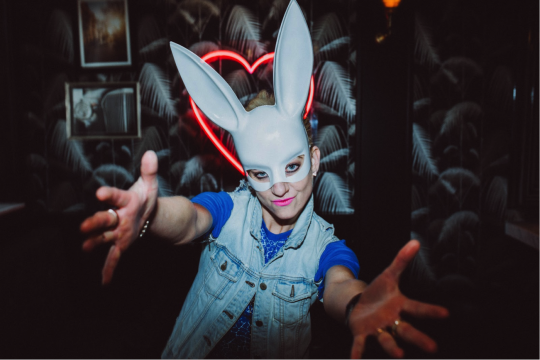
(DJ TRx, 2017. Photo by Amber Gress.)
#wellesley in art series#wellesley in art#tina romero#dj trx#class of 2006#queer dance party#park slope#renoir#confession#rainbowwarrior#shirley house
7 notes
·
View notes
Text
Become a portrait mode pro
New Post has been published on https://nexcraft.co/become-a-portrait-mode-pro/
Become a portrait mode pro
A blurred background means a ton of likes. (Allef Vinicius via Unsplash/)
Portrait mode photos are everywhere these days. Some shots look great, others… don’t. So if you want your pics to really stand out, there are certain techniques you need to know.
Since it was introduced with the iPhone 7 Plus in September 2016, some kind of portrait mode has been available on most flagship phones, including the iPhone XS, Samsung S10, and Google Pixel 3.
Either the phone has two cameras and uses the slight differences between the images to determine how far everything is from the camera (like the S10 and iPhone XS) or it uses a single camera, some technical trickery, and a lot of machine learning to figure out what’s the subject and what’s not (like the Pixel 3). No matter the method, the purpose is the same: to replicate the blurry background look of a portrait taken with a wide-aperture lens on a professional camera, like the photo below.
An actual portrait from a 30-year old film camera. Portrait modes won’t be able to make something this good, but they’ll try. (Harry Guinness/)
But because every manufacturer’s portrait mode uses software to mimic an optical effect, they’re not always reliable. Your phone has to clearly distinguish between the subject of the portrait (normally a person, but sometimes a dog, cat, or superhero model) and, well, everything else. When there’s a clear separation in terms of distance, contrast, and color, that process usually goes well, but when there’s any ambiguity, the software struggles. Let’s look at an actual portrait mode shot.
Who’s that handsome devil? Oh, it’s me. (Harry Guinness/)
This one’s actually pretty good. For the most part, the iPhone 7 Plus that shot this image managed to work out what was Harry and what was not-Harry. Still, there are a couple problem areas.
I’m pretty sure there’s a lot more to life than being really, really good looking. And I plan on finding out what that is. (Harry Guinness/)
If you compare my two shoulders, the one on the right is clearly separate from the white wall; it looks sharp, and as it should. The shoulder on the left, however, is off. My phone just wasn’t able to correctly distinguish between dark-Harry and dark-not-Harry, so it ended up blurring my black sweater into the dark background.
It’s the same story with the side of my face. Not only has the dark hair at my temple been blurred into the dark background, but there’s also a thin white line around my ear and sideburn, where the phone assumed some of the painting behind me was part of the foreground.
To be clear, I’m not trying to bash portrait mode. It’s incredible technology and the results can be super-good. I consider the photo above totally usable, but it’s a great illustration of where portrait modes can get things right, and where they can get them wrong.
How to make portrait mode work for you
Other than the slight blurring around Jeremy’s fingertips and a little weirdness around the edge of his T-shirt and left armpit, this is a great portrait mode shot. (Harry Guinness/)
Now that you have a better understanding of what portrait modes are trying to do (and where they’re likely to make mistakes), we can look at proper technique. You can’t just throw your phone in portrait mode, start shooting, and expect good results.
It’s all about the background
Because portrait modes blur the background, it’s the background you really need to focus on. You’ll want to pick one that contrasts your subject. If the person you’re taking a portrait of is wearing dark clothing, you’ll want to find a light background. If they’re wearing light clothing, put them in front of a dark one.
And it’s not just color contrasts we’re looking for. If you can find a contrast in textures, that’s even better. For example, if your subject has soft, floppy hair, you’ll get the best results if you use a plain background—a soft, textured background will end up blurring into their hair. On the other hand, if your subject is wearing a plain white T-shirt, have them stand in front of a hedge or another highly textured surface. Your phone will have an easy time figuring out the difference, and the background will look great in the final image.
Keep your distance
Portrait modes work best when your subject is between four and six feet away from you. Outside that sweet spot, the techniques used to separate the subject from the background won’t work properly.
The distance between your subject and the background is even more important. The bigger the physical separation between the two, the easier it will be for your phone to accurately gauge depth and take a better photo.
Vary the blur
The worst portrait mode shots are the ones where there’s just too much blur, and every transition looks soft and unnatural. The good news is there’s an easy fix: dial down the amount of blur.
Apple, Samsung, and Google all offer a way for you to adjust the amount of blur applied to your images. Use it to find the right amount for each image you shoot.
On an iPhone XS, open a Portrait mode photo in the Camera Roll, tap Edit, and then use the Depth slider to adjust the blur effect.
On a Samsung S10, you can adjust the depth slider while you shoot, or afterward by opening your photo in the Photo Gallery and selecting Change Background Blur.
On a Google Pixel 3, open an image in the Photo Gallery, then tap Edit and Depth. Use the sliders to adjust the blur, and even select a new focal point.
Remember that portrait mode portraits are still portraits
Okay, this wasn’t shot with a smartphone, but it nicely illustrates the tips for taking good portraits. (Harry Guinness/)
Images shot in portrait mode might look fancier than regular photos, but a bit of background blur can’t make up for bad technique. If you want to take a good photo with your phone’s portrait mode, you also need to take a good portrait. How? Glad you asked.
Use shade and windows
For portraits, you’ll find the best light either in the shade outside (like under a tree or in an alley) or coming through a big window. Both settings provide wonderful, flattering, soft light that still leaves enough definition for your subjects to look good. Hard light, on the other hand—like that from direct sunlight—creates nasty, harsh shadows, especially on people’s faces. Position your subject somewhere shady or looking at a window, and you can’t go far wrong.
Talk to your subject
The best portraits you’ll take won’t be the awkward, staged ones, they’ll be the natural ones; the ones where someone is smiling after they’ve just laughed or have thought of something witty to say. The easiest way to get photos like these is to talk to your subject, keep making jokes, and simply never stop chatting away. Don’t let it become some silent, fashion-esque shoot.
Shoot lots
And don’t stop shooting. The more photos you take, the better chance you have that at least one of them will be great. Portraiture is kind of a numbers game. I have thousands of photos of gorgeous people looking utterly ridiculous because they’ve just sneezed or I’ve caught them mid-word. Whenever you’re taking portraits, shoot a dozen pictures for each look, location, or pose, then choose the best one. Digital photos are basically free.
Don’t force it
Portrait modes don’t work in all situations, or with all subjects. If you’re trying to take photos of a moving subject, or in low light, it won’t work well, if it works at all—every manufacturer’s portrait mode kicks up a fuss if it can’t find a good subject to focus on.
Ultimately, portrait modes are a great technological solution to taking photos that isolate the subject, but because they rely on software, not optics, you have to work with them to get the best results. At least for the time being, they won’t replace dedicated portrait lenses—but they’re getting close.
Written By Harry Guinness
0 notes
Text
Become a portrait mode pro
This story was originally published on Popular Science.
A blurred background means a ton of likes. (Allef Vinicius via Unsplash/)
Portrait mode photos are everywhere these days. Some shots look great, others… don’t. So if you want your pics to really stand out, there are certain techniques you need to know.
Since it was introduced with the iPhone 7 Plus in September 2016, some kind of portrait mode has been available on most flagship phones, including the iPhone XS, Samsung S10, and Google Pixel 3.
Either the phone has two cameras and uses the slight differences between the images to determine how far everything is from the camera (like the S10 and iPhone XS) or it uses a single camera, some technical trickery, and a lot of machine learning to figure out what's the subject and what's not (like the Pixel 3). No matter the method, the purpose is the same: to replicate the blurry background look of a portrait taken with a wide-aperture lens on a professional camera, like the photo below.
An actual portrait from a 30-year old film camera. Portrait modes won’t be able to make something this good, but they’ll try. (Harry Guinness/)
But because every manufacturer’s portrait mode uses software to mimic an optical effect, they’re not always reliable. Your phone has to clearly distinguish between the subject of the portrait (normally a person, but sometimes a dog, cat, or superhero model) and, well, everything else. When there’s a clear separation in terms of distance, contrast, and color, that process usually goes well, but when there’s any ambiguity, the software struggles. Let’s look at an actual portrait mode shot.
Who’s that handsome devil? Oh, it’s me. (Harry Guinness/)
This one’s actually pretty good. For the most part, the iPhone 7 Plus that shot this image managed to work out what was Harry and what was not-Harry. Still, there are a couple problem areas.
I'm pretty sure there's a lot more to life than being really, really good looking. And I plan on finding out what that is. (Harry Guinness/)
If you compare my two shoulders, the one on the right is clearly separate from the white wall; it looks sharp, and as it should. The shoulder on the left, however, is off. My phone just wasn’t able to correctly distinguish between dark-Harry and dark-not-Harry, so it ended up blurring my black sweater into the dark background.
It’s the same story with the side of my face. Not only has the dark hair at my temple been blurred into the dark background, but there’s also a thin white line around my ear and sideburn, where the phone assumed some of the painting behind me was part of the foreground.
To be clear, I’m not trying to bash portrait mode. It’s incredible technology and the results can be super-good. I consider the photo above totally usable, but it’s a great illustration of where portrait modes can get things right, and where they can get them wrong.
How to make portrait mode work for you
Other than the slight blurring around Jeremy’s fingertips and a little weirdness around the edge of his T-shirt and left armpit, this is a great portrait mode shot. (Harry Guinness/)
Now that you have a better understanding of what portrait modes are trying to do (and where they’re likely to make mistakes), we can look at proper technique. You can’t just throw your phone in portrait mode, start shooting, and expect good results.
It's all about the background
Because portrait modes blur the background, it’s the background you really need to focus on. You’ll want to pick one that contrasts your subject. If the person you’re taking a portrait of is wearing dark clothing, you’ll want to find a light background. If they’re wearing light clothing, put them in front of a dark one.
And it’s not just color contrasts we’re looking for. If you can find a contrast in textures, that’s even better. For example, if your subject has soft, floppy hair, you’ll get the best results if you use a plain background—a soft, textured background will end up blurring into their hair. On the other hand, if your subject is wearing a plain white T-shirt, have them stand in front of a hedge or another highly textured surface. Your phone will have an easy time figuring out the difference, and the background will look great in the final image.
Keep your distance
Portrait modes work best when your subject is between four and six feet away from you. Outside that sweet spot, the techniques used to separate the subject from the background won't work properly.
The distance between your subject and the background is even more important. The bigger the physical separation between the two, the easier it will be for your phone to accurately gauge depth and take a better photo.
Vary the blur
The worst portrait mode shots are the ones where there’s just too much blur, and every transition looks soft and unnatural. The good news is there’s an easy fix: dial down the amount of blur.
Apple, Samsung, and Google all offer a way for you to adjust the amount of blur applied to your images. Use it to find the right amount for each image you shoot.
On an iPhone XS, open a Portrait mode photo in the Camera Roll, tap Edit, and then use the Depth slider to adjust the blur effect.
On a Samsung S10, you can adjust the depth slider while you shoot, or afterward by opening your photo in the Photo Gallery and selecting Change Background Blur.
On a Google Pixel 3, open an image in the Photo Gallery, then tap Edit and Depth. Use the sliders to adjust the blur, and even select a new focal point.
Remember that portrait mode portraits are still portraits
Okay, this wasn’t shot with a smartphone, but it nicely illustrates the tips for taking good portraits. (Harry Guinness/)
Images shot in portrait mode might look fancier than regular photos, but a bit of background blur can’t make up for bad technique. If you want to take a good photo with your phone’s portrait mode, you also need to take a good portrait. How? Glad you asked.
Use shade and windows
For portraits, you’ll find the best light either in the shade outside (like under a tree or in an alley) or coming through a big window. Both settings provide wonderful, flattering, soft light that still leaves enough definition for your subjects to look good. Hard light, on the other hand—like that from direct sunlight—creates nasty, harsh shadows, especially on people’s faces. Position your subject somewhere shady or looking at a window, and you can’t go far wrong.
Talk to your subject
The best portraits you’ll take won’t be the awkward, staged ones, they’ll be the natural ones; the ones where someone is smiling after they’ve just laughed or have thought of something witty to say. The easiest way to get photos like these is to talk to your subject, keep making jokes, and simply never stop chatting away. Don’t let it become some silent, fashion-esque shoot.
Shoot lots
And don’t stop shooting. The more photos you take, the better chance you have that at least one of them will be great. Portraiture is kind of a numbers game. I have thousands of photos of gorgeous people looking utterly ridiculous because they’ve just sneezed or I’ve caught them mid-word. Whenever you’re taking portraits, shoot a dozen pictures for each look, location, or pose, then choose the best one. Digital photos are basically free.
Don't force it
Portrait modes don’t work in all situations, or with all subjects. If you’re trying to take photos of a moving subject, or in low light, it won’t work well, if it works at all—every manufacturer’s portrait mode kicks up a fuss if it can’t find a good subject to focus on.
Ultimately, portrait modes are a great technological solution to taking photos that isolate the subject, but because they rely on software, not optics, you have to work with them to get the best results. At least for the time being, they won’t replace dedicated portrait lenses—but they’re getting close.
from Popular Photography | RSS https://ift.tt/34na7Wa
0 notes
Text
‘Lady Bird’ DP Sam Levy on Working with Greta Gerwig, Harris Savides, and More
by Adam Chitwood,November 3, 2017
source: http://collider.com/sam-levy-interview-lady-bird/#greta-gerwig
I know that you worked with Greta on a couple of Noah Baumbach’s films but I was curious, how did you first come to be involved in this?
SAM LEVY: Greta and I did three movies together. Frances Ha and Mistress America with Noah Baumbach and Maggie’s Plan with Rebecca Miller. We’ve worked together a lot and knew each other for many years before she offered me Lady Bird. She actually first mentioned it to me at a premiere party for Mistress America and she was extremely humble in the way that she brought it up. She said, “I wrote this thing that I’d like to direct and I’d love to show it to you but if you don’t want to look at it, it’s totally fine. If you do look at it and you don’t want to shoot it, that’s totally fine.” I was like, “Oh, just can I please read it?” I knew she was working on something. It’s like, “First of all thank you for thinking of me because I know it’s going to be amazing and yeah, I’d love to read it.” I read it. It’s such an amazing screenplay and that was it. It was probably a couple days after that we met at the Noho Star restaurant in the East Village and just started talking about it.
That was another one of my questions was what were your early conversations like in terms of the visual approach to this film? What were some of those early ideas?
LEVY: One of the first things Greta said to me was that she wanted the movie to look like a memory, which immediately got my attention and made me excited. When she said that I knew exactly what she meant, but despite knowing what she meant, the thing was, how do we do that? How do we create something that looks like memory? Something that’s dynamic that isn’t just using commonplace methodology that everyone uses nowadays in motion pictures like making things sepia or just crude black and white or diffusion. It’s not about that. It’s more of an organic and internal sensibility. We talked about it some more. I said, “I know what you mean but let’s keep talking about it.” She said, “Yeah, at a visceral level it should feel like the movie is over there.” She extended her arm and held up her palm as if to say, you’re connected to the movie but my palm, which is the screen, is slightly removed from the viewer, but not overly so. We talked about it some more and then together, both of us equally came up with … I think she said, “It almost should be plain. It should almost look plain,” and I said, “But luscious.” She said, “Yeah, plain and luscious.” We started saying that a lot. Plain and luscious. Plain and luscious. It should be beautiful but not distractingly graphic, so that you can engage but have a nice aesthetic bed to fall into and luxuriate in but not distract from the story or the performances or the words.
Did you guys shoot this on film or digital?
LEVY: We shot it with an Alexa. Digital.
That’s surprising, honestly. Because it has that feel that you’re talking about where it’s somewhat—I feel like sometimes with digital it’s too lifelike, too realistic, and you don’t have that sheen of watching a movie.
LEVY: I think Greta’s first thought was it shouldn’t be too real. It should be a little removed. It should feel like a memory. The way that a memory looks when you envision it. From there after we had these great allegorical conversations where we started to get at the technique of memory and cinematography. A photographer that we were looking at a lot was Lise Sarfati, who’s this brilliant French photographer. She’s done a lot of amazing work. She’s done these amazing portraits of young women about the age of Saoirse’s character and they’re very sensitive and soulful. We were just looking at different photos from the era. A lot of high school yearbooks. It’s a high school movie. High school yearbooks from the early 2000s and we started to notice, especially in high school yearbooks, photos have this quality of—they look crappy and distressed. It’s like a color Xerox or it’s taken with a point-and-shoot 35mm camera. By the time they make it into the yearbook, it’s like several generations have been removed from the initial image.
We happened on this technique in the production office. I took a photography book we were looking at and I made some color copies of some different photos because I wanted to tack them up on the wall so Greta and I could look at them and be inspired. Just have things to look at while we were shot-listing and digesting all the location photos we were taking. I started to notice when making these photocopies, it distressed the image much like the yearbook photos, and sometimes you could take the photocopy and re-copy it and it’d lose another generation and you could lose another generation still and distress it to the point that it really looked like these yearbook photos but it was a technique we could utilize in our own way, in this professional context but still bearing in mind the youth who create their yearbooks.
That really cinched that it was this aesthetic of memory that we’d been talking about and then it got us talking about a lot of different things. The early 2000s was a time when high school kids, college kids, would go to Kinko’s and make copies of different things. Term papers or photos to decorate their rooms or their apartments or their dorms. It just seemed to evoke the era in all these different ways. Then we used these distressed images as a reference for how to photograph the movie using the Alexa. Meaning that the color photocopier has its own sensor that scans the image just like the Alexa has a sensor that captures the images in front of the lens. How can we emulate these multiple photocopied images using the Alexa? The quest then came to be, playing digitally which is totally appropriate but how can we create something within this aesthetic of memory that is unique and of its own and not just taking scans of film grain and overlaying them, calling it a day? Which is very commonplace now.
I think it works. I’m 30 so I came of age around the same time and something that really struck me about the film is that it feels of that time but it’s not dripping with nostalgia. I couldn’t quite put my finger on it but it feels like you pulled off a magic trick where it felt like I was transported there without feeling like the frame was loaded with “remember this” references or like you said, covered in sepia tone or something like that. I think that the memory aspect that you guys did, I think you really pulled it off.
LEVY: Oh, thanks. I’m glad you responded that way.
Were there any other discussions about that specific technique of transporting the viewer to that world without dripping in nostalgia?
LEVY: There was a lot of discussion about it. Much of it was grounded in the shot-listing process. Greta and I had the benefit of a lot of lead time and we also both live in New York and we liked hanging out with each other so we would get together on weekends or whenever we were both off and we could find a few hours here and there, and we just started going through the movie. I would sit at my computer and I would read the script to her so she could hear her dialogue and then we would just mark down, “This one, we can try and do this all on a wide. We’ll move around, we’ll follow Lady Bird. This scene, she’s in the car with her mom, we’ll probably want some additional close-ups.” We’d try to anticipate editorially where she would want to cut in and out and especially the transitions from scene to scene. We shot-listed the movie twice. We managed to get a pass done before the official prep for the movie started and when the official prep started we went through it again and this time I added all kinds of photos and stuff to each scene. I’d always diagram the blocking. I had a piece of graph paper and I would diagram, “Lady Bird’s going to be here by the door and then she’s going to move to the kitchen, then she’s going to move back to the door and Laurie Metcalf is going to stand still. Tracy’s going to be following,” and so on. Where appropriate I put maybe a reference photo of Lise Sarfati or the Sacramento painter Wayne Thiebaud.
Then during prep what I started doing a lot of was I had location photos, especially once we’d locked locations. I’d put them in. When it was all said and done the shot list was 110 pages, which is about the length of the script. Greta and I pretty much had that thing memorized by the first morning of our first shoot day. We had a brilliant First AD Jonas Spaccarotelli. The three of us really had that thing down and we distributed it to everybody, to everyone on my team, everyone on the AD team, production design, costumes, sound, everybody. Everybody had a sense of “Here’s what we’re going to try and do.” Of course we’d shift and change some things, as happens, but never drastically. Greta and I would know right away if we’d look at a blocking, maybe one of the actors had an idea or we’d just glance at each other and we’d know we need to do less. Usually it was we need to do less than what we’d anticipated.
To answer your question, the planning of the character blocking, the camera blocking, really informed creating the aesthetic of memory. Even though you don’t sit there and be like, “When she’s walking through the parking lot how can we make that like a memory?” Not really about that. It’s just designing everything to be as dynamic and lively as possible with the best possible transitions. Then with that we used the technique of distressing the image just up to the point where—when we were doing tests and especially when we were timing the movie, we’d push things in lighting the movie, photographing the movie, push things up to a point where it was like, “That’s too much. Now it’s too luscious. It needs to be more plain.” We’d always know the moment something was too luscious or would override the story or what people were saying. Really it’s that the design of the image needed to fit alongside the tempo of the work. The musicality of the dialogue and the music itself, the score by John Bryant. The editing by Nick Houy and then Chris Jones’s design, April’s costumes.
What really struck me about the film was that there’s this confidence and this assuredness behind the camera without the pretension or pomposity, which was refreshing given that Greta isn’t some veteran director. It feels like she’s been doing this for years and the way she handles the characters is just brilliant. What was your working relationship like on the set with her as a director?
LEVY: It was amazing. As good as it gets. It was absolutely what you dream about. As I mentioned we had this exhaustive amount of prep. Everybody really put in a lot of work making a blueprint and designing things to be just how we wanted them and then when we got to the shoot, of course everyone has butterflies before the first couple of days. You just really have to stay on the ball, stay focused, make sure everything’s fitting together with the schedule. There’s a lot of pressure. We want to create something transcendent and in order to do so we have to be very responsible to the schedule, to our budget, to our producing team who are amazing, very supportive, and positive. Greta was just so in her element on set. Working with the actors, working with us. Being a great collaborator, giving us room. She played music. She had all these great playlists that she’d made. A lot of songs from the era, from the early 2000s, all kinds of different songs. She knew exactly when to play music. When we were setting something up and the actors were maybe off preparing their lines or something. It just really created a great atmosphere. Then just about at the time we were wrapping up she’d slowly fade it out and then we’d get to work and start shooting.
That was indicative of the attitude towards the whole. She was just highly focused, highly efficient but not prone to pulling all-nighters and working recklessly hard. She’s just very engaged. It’s inspiring. She was constantly inspiring all of us. Then she has wonderful taste. She loves great films, great music, she’s a voracious reader. In that way she’s inspiring to all of us also. All of us, we’d do anything for her. She just got us to a point where you want to move heaven and earth for that kind of person.
That’s so great to hear and I definitely see much more from her to come as a filmmaker, because again as I said it feels like she’s been doing this for years.
LEVY: It does. The fact is, she has. She hasn’t actually directed a movie on her own but she’s worked with amazing people, actors. Written, co-directed. She’s done so many things on great movies with great cinema personalities. She certainly absorbed a lot of that but the fact is she’s her own cinematic being. I knew that the moment she said, “I’ve got this thing, would you read it?” It’s like, “This is going to be amazing.”
0 notes
Text
Panavision revives 70mm for a digital world: part 2
Does large format really create a greater sense of depth and dimensionality in a flat image? Read on to find out…
If you haven’t yet read part 1 of this series, you can find it here.
MAGNIFICATION: REALITY’S NEW BEST FRIEND
Let’s start with a couple of images, which will save us a few thousand words of explanation:
This is where the “epic” look, that I remember from Panavision Super 70 films such as Lawrence of Arabia and Doctor Zhivago, comes from. There are three things to notice here:
• The subject’s face is round in the bottom image, while it appears wide and flat in the top image.
• The background appears closer to the subject in the bottom image.
• Depth of field is reduced in the lower image, even though the angle of view is nearly the same.
To make this more obvious, I’ve made an animated GIF that flips between these images:
Tight lenses magnify the image. This is easy to visualize, as we all know that longer lenses make objects appear larger in the frame than shorter, wider lenses. Standard Super 35mm focal lengths project an image that fits perfectly on a Super 35mm sensor, but fill only the very center of a 70mm DXL sensor. Resizing that tiny Super 35mm image to fit on a 70mm sensor requires magnification, and that is achieved by using a lens of a longer focal length. In this example, a 50mm lens on a 70mm sensor roughly matches a 27mm wide angle lens on a Super 35mm sensor.
While the angles of view are roughly the same, a longer lens is still a longer lens. They don’t show the same kind of distortion that we see in wide lenses, and this results in a wide angle image that reproduces shapes in a more accurate and pleasing manner than is possible when shooting in S35 with the same angle of view. The fact that the background feels closer results in increased background detail, even though that background is softer. Sometimes the larger background creates an increased sense of depth, as depth cues become visible on the background itself. And the ability to throw the background out of focus on a wide shot, if desired, becomes a powerful tool in guiding the eye around an extremely high resolution image that may only be on the screen for a few seconds.
I found the following quote relating to large format cinematography in an article on the American Society of Cinematographers website:
“You get these incredibly big shots, but you don’t feel that they’re wide angle… You feel like you’re right there, in the moment. And that’s a really unique experience. It has to do with how the image size and the magnification work together.” -John Schwartzman, ASC
It’s good reading, so be sure to take a look when you’re done here.
35MM ANAMORPHIC VS. 70MM SPHERICAL: CLOSE, BUT NOT QUITE
The following images, found on Wikipedia, show the difference between spherical 35mm film capture and anamorphic film capture:
Spherical 35mm film.
Anamorphic 35mm film. By Andreas -horn- Hornig, courtesy WikiMedia.
The angle of view captured by a spherical lens on a 70mm sensor is nearly the same height as that captured by an anamorphic lens on a 35mm full frame sensor. This is because each lens has roughly the same magnification, at least in the vertical axis.
A spherical lens simply projects an image onto the film or sensor. An anamorphic lens squeezes the image first, projecting an image that’s taller than the standard 35mm frame while also compressing it horizontally by 2:1.
The excellent IOS app PCam shows that, for the same focal length lens, both formats see roughly the same angle of view:
This does not mean that these formats are completely comparable in how they render perspective. Anamorphic lenses are effectively two lenses in one: a longer focal length vertically, and a wider focal length horizontally. A 50mm anamorphic lens, for example, is a 50mm lens in the vertical axis and a 25mm lens in the horizontal axis, while a spherical lens is 50mm in both axes.
You should see some of the benefits of large format cinematography simply by shooting 35mm anamorphic on a full frame sensor. It won’t be completely the same, though: the squeeze eliminates a fair bit of horizontal resolution, so while vertical resolution is increased, horizontal resolution is significantly decreased. And a 35mm anamorphic image certainly can’t compete with a full resolution image captured through a spherical lens on an 8K sensor. (If you want to be the ultimate overachiever, Panavision makes anamorphic lenses for the 70mm format.)
While many of us enjoy the anamorphic look, it’s nice to have the option of the spherical look, with less distortion and higher resolution but the same depth of field.
SUMMARY: PUTTING IT ALL TOGETHER
During an email exchange with Michael Cioni, Senior Vice President of Innovation for both Panavision and Light Iron, he made a series of comments that I felt summed all this up perfectly. I repeat them here with his permission:
If we simplify the question about sensor resolution, we are always met with an interesting fork in the road. In order for digital sensors to achieve a large format aperture, there are essentially two main options:
Increase the pixel pitch and plot them on a larger target, maintaining the same resolution
Shrink the pixel pitch and plot them on a larger target
In the first choice, if you were to increase or expand the size of each pixel and spread them out, you would notice an increase in contrast as well as introduce additional artifacts that make the image appear to have a “duotone” effect due to macro blocking that would render the images very sharp (this is a common problem with large electronic signage). However, when you shrink the pixels and plot them on a bigger target as in choice two, something interesting happens…
Smoothness.
That’s the word our DPs seem to keep circling back to. Somewhat serendipitously, “smoothness” is also a common word used to describe what the still photography market has experienced as they, too, have transitioned to an increase in resolution coupled with a decrease in pixel size. Most people (photographers and cinematographers) generally prefer the benefits of large format when shooting images. The irony is, in order for the large format properties to work, your resolution automatically goes up.
This is a key concept to unpack because the general consensus among artists is to assume that resolution is the goal of making a better sensor when in fact, it’s merely a result. In order to provide smother images with a noticeable increase in field of view and depth of field control, resolution must go up. Yet when this happens to the polygons forming pixels on a CMOS imager, the increase in pixels actually lowers contrast and increases transition from one code value to the next. That transition then allows a sensor to better apply its fixed dynamic range values across more area (particularly smaller areas), which effectively increases the dimensionality of an image (what we qualify as smoothness) because a smoother transition gives the illusion of increased depth.
An over-simplified way of saying it is you can’t assign all available dynamic range to an element that can’t be resolved. An increase in resolution increases precision, which allows more available dynamic range to be applied to subtle areas of the frame creating more transition.
Here’s how these concepts play out in a very basic chain-equation:
Increased sensor size = increased resolution (provided the pixels remain small)
Increased resolution + sensor size = increased magnification (improving field of view and depth of field characteristics)
Increased magnification = more dimensional separation (z-depth creative control)
Increased dimensional separation = increased precision placement for color application
Increased color application = more granular transitions (from bit to bit)
More granular transitions = less contrast (less binary or coarse bit transition)
Less contrast = less perceived sharpness
Less perceived sharpness means images appear smoother
The above concept does not mean that lower resolution cameras produce poor images. That is simply not true, nor do I believe that. However, the above chain equation explains why higher resolution, when coupled to a larger target, creates smoother results. And in the pursuit of increased quality and precision, the higher resolution image is going to have more of a positive impact than people may initially suspect.
The most common criticism I hear from skeptics in regard to DXL and RED’s 8K sensor program is that it’s going to make images sharper to the point that you’re going to see inside the pores of a face. But when they come back from a shoot, it is common to hear artists say, “These are some of the best images I’ve ever shot.” What’s more, the DXL program has an extremely high repeat customer factor to which cinematographers are returning for their 4th or 5th shoots on this sensor. When they ask us what is going on that makes this 8K image look so good, I ask them if they have a still camera. Many DPs now carry the Fuji GFS or SONY Alpha series cameras, with the a7R I and a7R II being among the most popular. When they make the connection between what their still cameras can do, with their high megapixel count, and DXL’s large 8K sensor, they begin to consider that resolution may not be their enemy. In fact, many describe DXL as the first cinema camera that takes images that look like some of the best still cameras on the market… only now they can move.
It has been said by many, “We don’t want more pixels, we want better pixels.” This language confuses me. So I challenge supporters of this concept to define “better pixel.” A conclusion we come to is that a better pixel has higher precision with better, brighter, more colorful, controllable output. What we have learned with RED over the past few years is that a better output requires a better input. So in the interest of achieving a better pixel, the system that can capture a superior input (resolution included) will always produce a superior output.
-Michael Cioni Senior Vice President of Innovation Panavision & Light Iron
Add to that the optical component, where large format lenses normalize wide angle perspective so the audience senses greater depth but without feeling 35mm wide angle distortion, and you’ve got a recipe for greatly enhanced dimensionality that one can feel on nearly any size of screen.
I’m going to leave you now with two videos that are the best examples of the 70mm look that I could find online. One is a collection of clips from the film Lawrence of Arabia, a personal favorite of mine, shot beautifully on 65mm film using the Panavision Super 70 system. The second is a project produced recently by Panavision. While these films initially look different, there are commonalities: they are soft yet full of detail; they are rich in subtle color and tonal variations; and they both have that epic wide-angle-without-distortion look that I relate to large format films from the mid-20th century, when motion pictures weren’t simply entertainment, but were also spectacles.
Panavision, 1961:
Panavision, 2017:
Thanks very much to Panavision and Michael Cioni for their assistance in helping me research this article. All images ©2017 by Panavision except where noted. Any errors and omissions in this series are mine alone.
Art Adams Director of Photography
The post Panavision revives 70mm for a digital world: part 2 appeared first on ProVideo Coalition.
First Found At: Panavision revives 70mm for a digital world: part 2
0 notes
Text
faster isn’t better, just a different way of experiencing the world.
shooting film makes you see things in a different way, helps you to slow down.
letting the emotion age inside the subject
sharpening your focus
analog technologies often take longer to complete the task at hand. to appreciate shooting film as a medium, you have to appreciate the time the process takes. take less shortcuts. not saying emotion captured in digital photos is not as good, it just represents a faster experience. emotions more fleeting things that we don’t understand soon after we start to focus on them longer. but when we take more time with things, we dive deeper. and as different emotions often shift the speed of our experience, it may make sense to focus on the emotions that make us take on a slower speed. the things we don’t want to focus on being it may feel more difficult to experience time at a slower pace. happy (fast) sad (slow). i think the speed at which you experience the transitions between emotions may need to be considered. the difference between people who experience deep depression in their youth vs. those that don’t experience it until they’re married with kids. one day you realize how long you’ve actually been away from happiness, and you could be unable to remember how to exist in that way. you lose sight of happiness. you can’t remember just what it feels like. you never realized YOU could be depressed. you never thought you’d get tired of living within what society praises. you thought you’d always care about wanting to be accepted. but once you realize you HAVE to go down the path of actually understanding yourself to cope with existence, you may be so overwhelmed with the task of understanding yourself that you give up and take out your aggression towards existence on other people’s existences. having these experiences later in age in a society that allows people more power with age, leads to a society lead by people with little capacity for awareness of themselves and their surroundings. experiencing depression from a very young age, depression of your spirit. you imagine children as happy, free-spirited. their energy exerting out into the world, not so much inner understanding. but when you become depressed, your spirit gets small. you feel small. more outer energies are let in. weighing on you instead receiving the impact of your powerful inner energy. your spirit imprisoned by the weight of your surroundings. the earlier, more intensely you experience this deep level of depression, the longer it has to deepen, the more weight you carry with you. queer black femmes carry the most weight by nature of our current society. i don’t think you can be doomed to the depths of depression, but i think that the deeper you go, the more you have to work to reach a balanced medium between happiness and depression. sometimes growing outward as a person is enough to sustain balance, but in my experience, growing outward isn’t enough. i need to consistently be looking inward, dragging myself up out of the dark side of things. digging myself out of the hole. you can let other things help you, but ultimately, you’ll gain strength if you do it yourself. you may be less likely to fall that deep next time. the longer you let your depression sit without addressing your responsibility to your self to actively dig yourself up from the whole, the farther you go from the light. you could fall so deep that it becomes a tiny dot in the distance. then you lose sight of it completely. so many people get lost in the darkness. like i said, i don’t want to believe that anyone is doomed to those depths forever. it could take a very bright light to help them back up. i feel like i am finally in a place where i am almost stable. my inner strength has been growing and i’m growing more comfortable at the depth of my dark inner truths.
photo: person looking up at distant light. shining just on their face. like you were in a hole looking up at a circle of light, the closer you get to it, the closer it feels to the surface. i don’t feel like i’m existing at the surface most of the time, i often feel below it, so that’s where a lot of the lighting in my photos comes from. daytime photos just don’t feel honest to how i feel most of the time. i know when a genuinely happy photo in the daytime light feels right to me. when i feel its honesty. but i think a lot of people have depression, so a lot of people are operating under the surface. the beauty in darkness is its shared experience. the way light looks so different surrounded by darkness. it makes you appreciate it more. in the daytime there’s so much light, you don’t appreciate it as much. you have all day to enjoy it. the fleeting feeling of sunset, the awakening of sunrise. when light is surrounded by darkness, it becomes the focus. what is illuminated by the brightest point of light? what is the fluidity between the light and the dark? harsh lines or softly blended. a photo series where you just see all darkness with the only light being on parts of my face. fading into darkness. or the opposite, it seems as if my inner light is radiating outwards into the darkness. the glowing, bring light of a person in a dark surrounding. or it could be a balance, where the light within the subject and it’s surroundings appears to be of equal brightness. conveying emotion in photos through the appearance of one’s inner light. maybe i should try and find a way to make somebody glow in the daylight. in addition to the way i make them glow or fade into darkness, they can glow or fade out of light. making the subject darker or brighter than the light. or maybe the light surrounding the subject gets darker. a thick light around a subject, drawing their brightnesses to more similar levels. it’s a heavy light. anyways ... the subject as a being that can be brighter, the same brightness, or darker than it’s surroundings, and how that correlates with the emotion and surrounding you’re conveying. it’s subject and surrounding. the surroundings that the emotion exists within gives it context.
i feel like in my view of the future, it has to be dark, it’s dark now and it’s only going to get darker before it gets lighter. i don’t know if it will get lighter within our lifetimes. i really hope it does, but for now, the light is only going to get thicker, heavier. the people with the most weight on them are the most likely to get crushed by the increasing weight of the world. but some people are such bright lights despite how dark their surroundings are by society’s design. some people move their energy so seamlessly through their surroundings. flowing. knowing that you can survive at such a difficult level gives you strength. gives you the strength to make an impact on your surroundings. i gotta represent people how i feel their energies within the surrounding. maybe place those energies in unusual surroundings and see what effect it has.
photo: eye fading into darkness. lots of negative space, like the eye is the last thing to go before completely fading into the darkness. falling into the darkness. eye has the expression of falling into darkness, you’re scared.
october 19 2017 1:26am
a slide in (new drugs) - king krule
0 notes